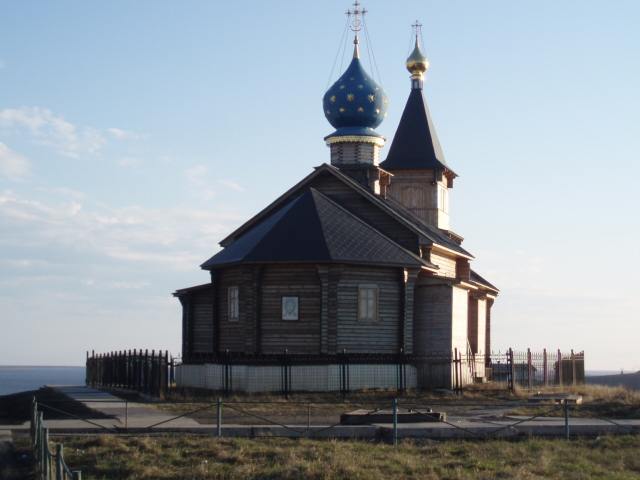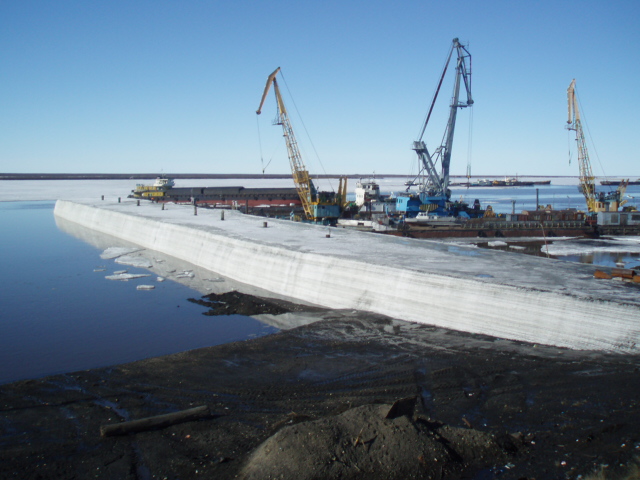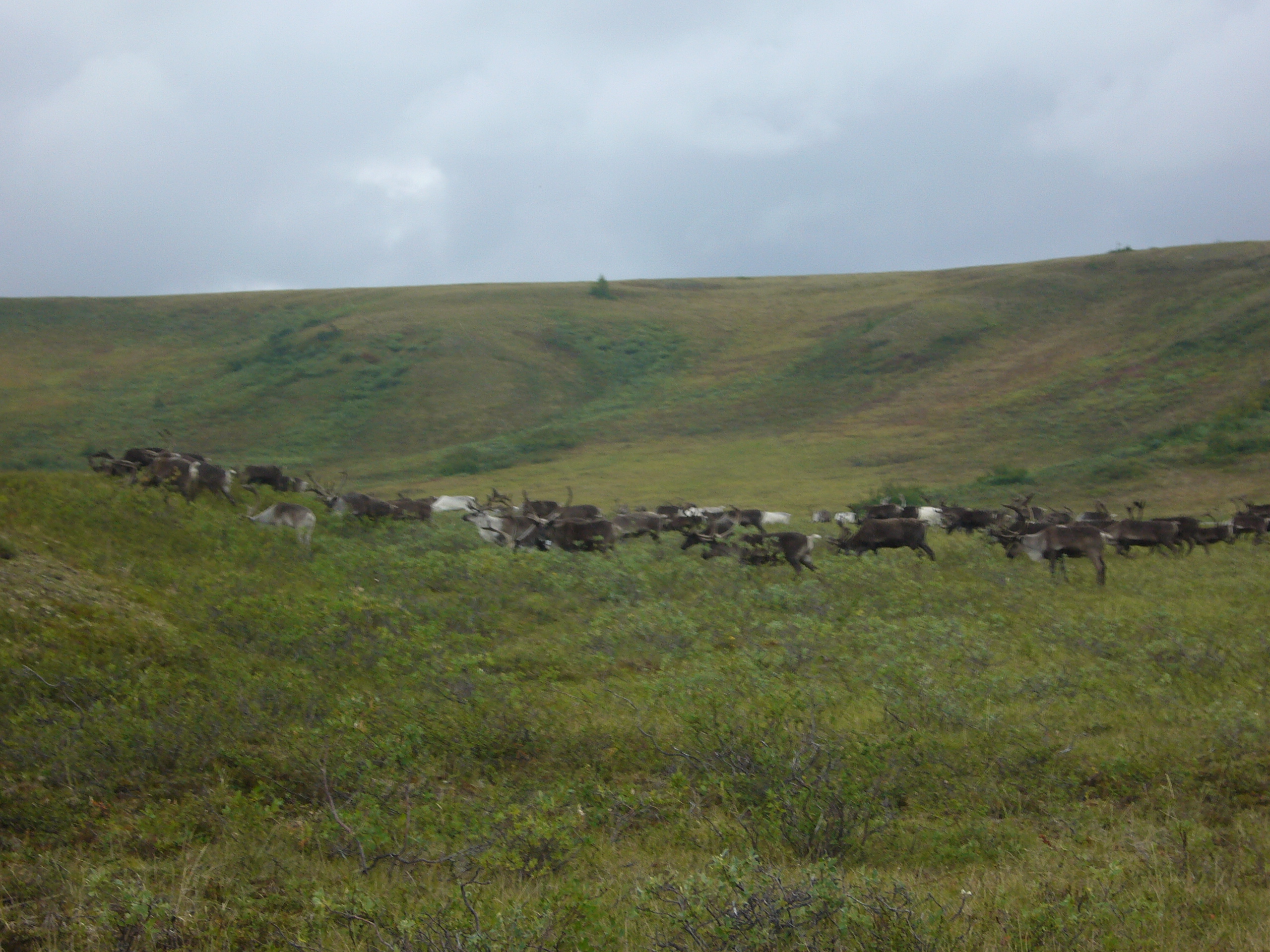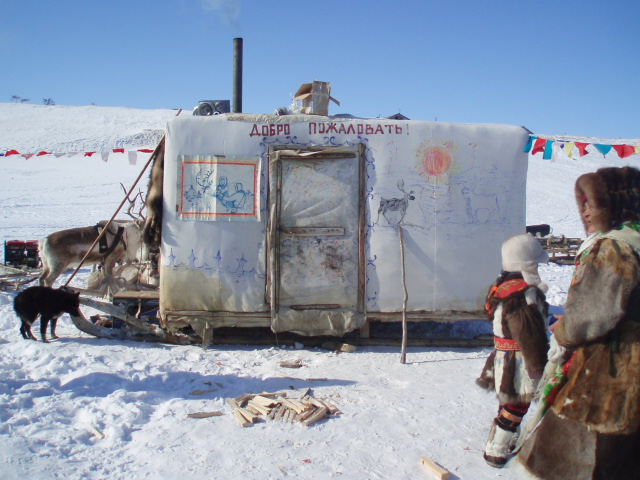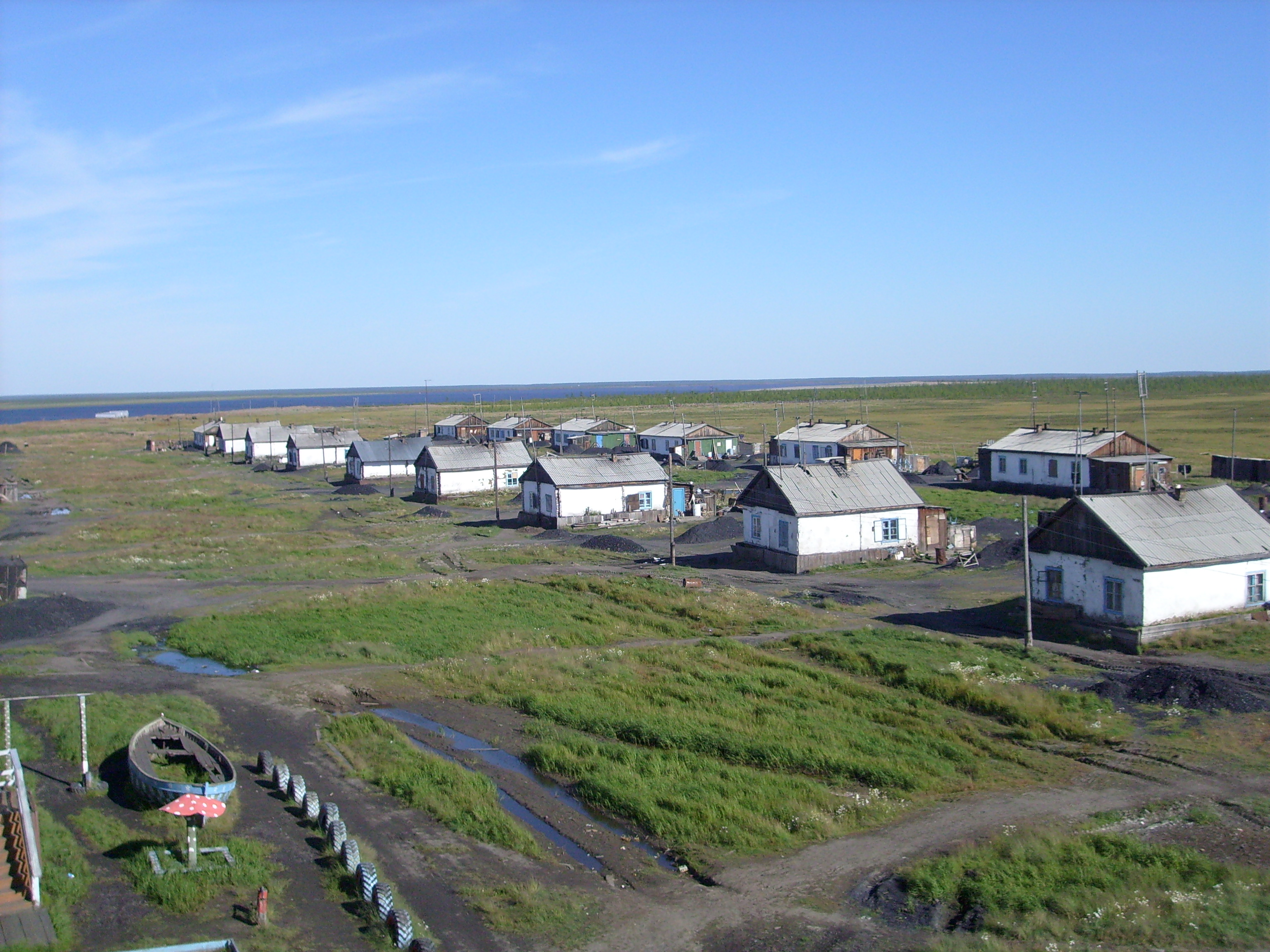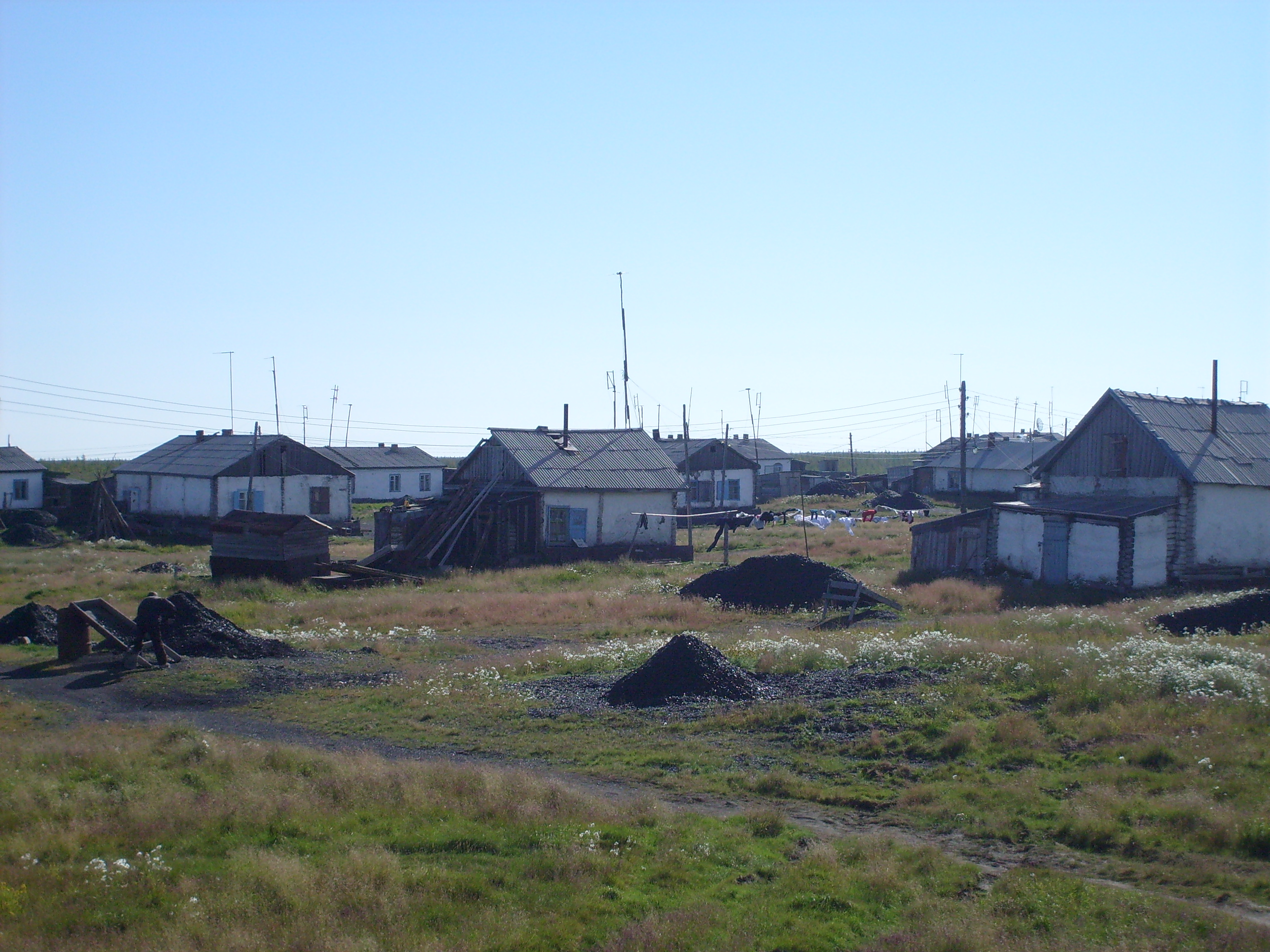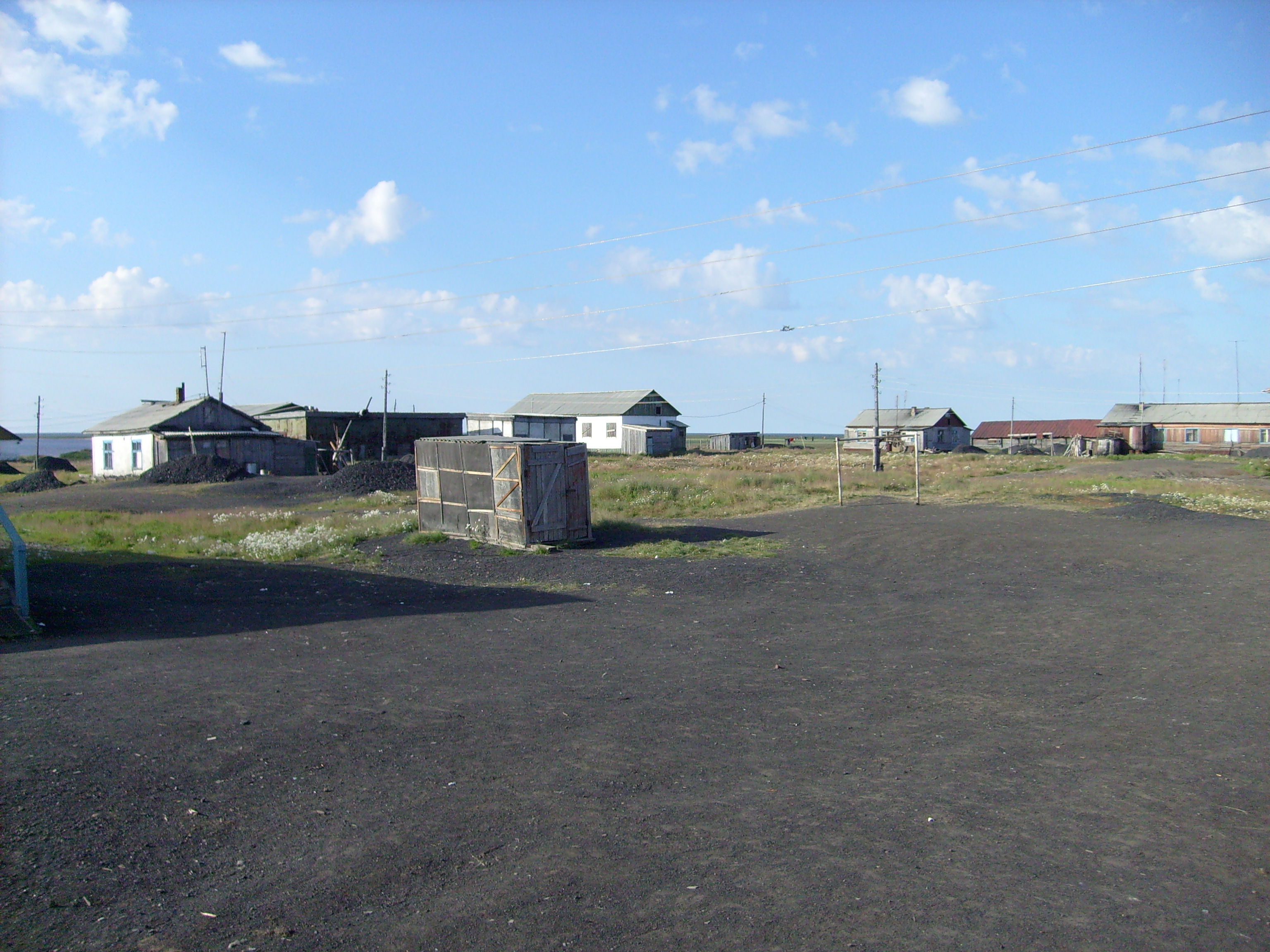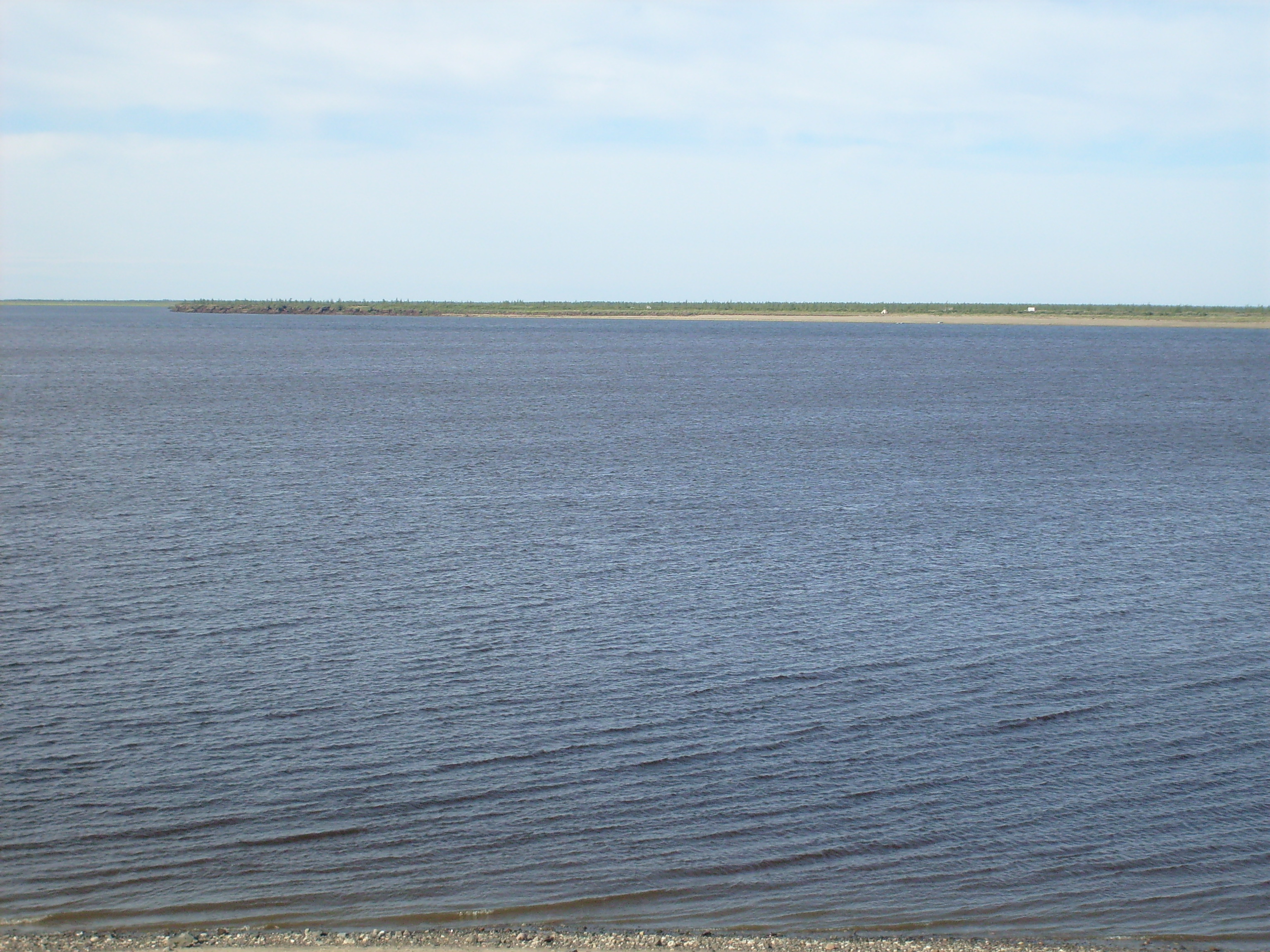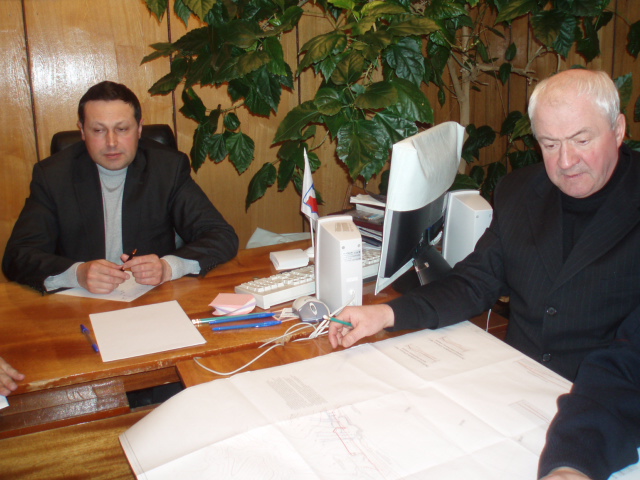Communidat
- Details
- Parent Category: English
- Category: Communidat
-
Also available:


- Hits: 6873
"Solar Kheta." Exactly residents called their village, although it is not on the southernmost parallels territory of rural settlement Khatanga. on the right bank of which the village is located. The name of the village gave the river of the same name. He was removed from the Khatanga 140 kilometers upstream Kheta. Place picturesque. The village is surrounded by the northern larch forest, like all Kheta his "relatives", ie villages southern bush. In forest undergrowth for the period of the short Arctic summer time to mature berry wealth - gift Northerners from a long, saturated light polar day. Berry period is very short. After each other mature cloudberry, blueberry, cowberry - favorite natural (In modern vocabulary urgent to say "clean") goodies northerners. During the harvest in forest, literally, "gardens" - generous, blue, alluring. Berry culinary semimanufactures - good support the long winter. Locations former farms or winter hut was chosen redcurrants, less - canker-rose. North land is rich mushrooms places. And how many medicinal herbs on the banks of rivers and lakes.
Officially Kheta counts his age since April 17, 1928, according to the recommendations of archival information. Most villages Khatanga region, including Kheta, formed as factories Gostorg in the late twenties. In this regard, and to determine the date of birth Kheta.
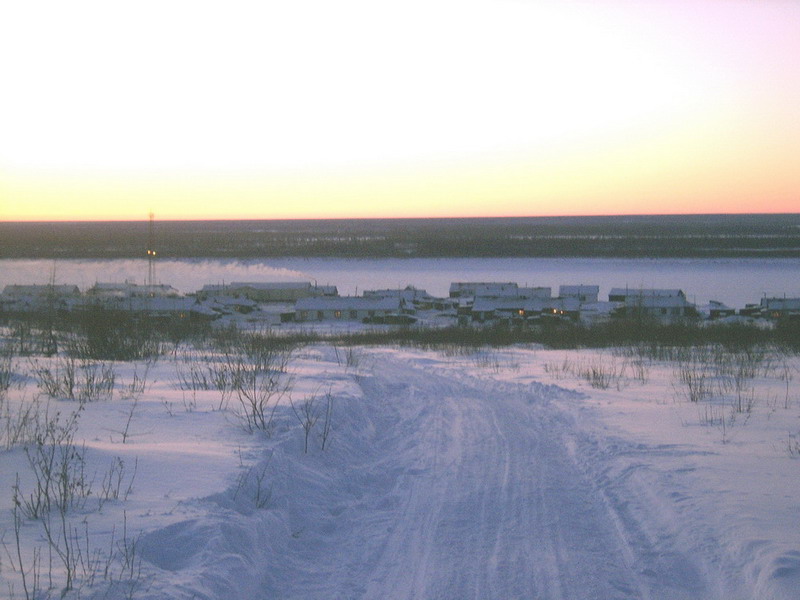
View of the Kheta
But in fact the same data archives can tell, Kheta wintering arose with the arrival of the first explorers to Taimyr. Of course, several hunting houses can not be considered a village. But villagers Kheta tend to believe that its historical roots lie somewhere in the seventeenth century.
In the thirties of the last century, when the active collectivization in Khatanga area, the population, was mainly, nomadic natural for him a way of life. Of course, collective education process was difficult. On the territory of factories in 1937 farm was established, was named Voroshilov. Villagers Kheta remember the name of the first chairman - it was Chardu Pyotr Vasilievich.
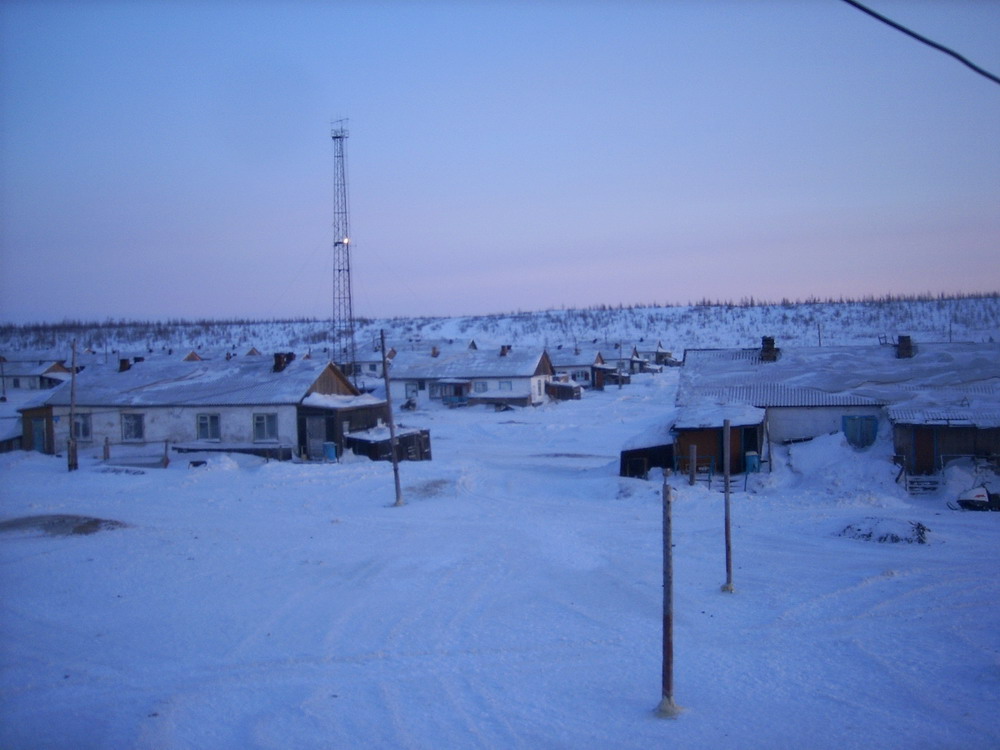
Evening Kheta
If you get in this southern from Khatanga. Not reaching ten kilometers to Kheta, on the right bank of the river can be seen two or three small houses (Now it is a hunting and fishing point) – Mutino. This is all that remains of the former collective farm named after Stalin, who in 1953 due to the small number worker, combined with the kolkhoz Voroshilov and renamed the farm "Precepts of Ilyich" subsequently (From 1980 to the transformation of perestroika) this - "Hetsky" farm. A mutinskie familys moved into Kheta together from their homes : them, constructed of sturdy wood northern larch, just moved to a new residence.
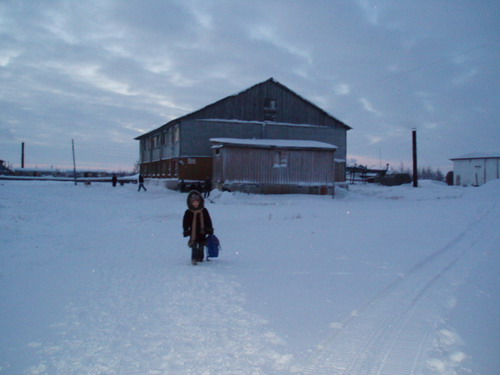
On the street Kheta
In those years, on the peninsula were organized kultbazy for indigenous peoples, task which is defined as the elimination of illiteracy, the preparation for the transition to a sedentary lifestyle, introduction to the elements of the culture and way of life, recovery of the nomadic population. Actively working activists in the "red tents", nomadic with herders. Since 1937 came “krasnochumovtsy” and in Kheta : taught children and adults to read and write, tell about life on "big ground", a great country, citizens which are, were northerners - Soviet Union, clarify the nature of the established power in the country.
The Great Patriotic War led him to the field of battle, fourteen volunteers from a small village, which became a single system of Soviet soldiers-defenders of the motherland. People of Taymyr fought near Moscow, participated in the defense of Stalingrad, in the liberation from the Nazis in Eastern Prussia and Poland. Not everyone returned to his native village. And those who have returned, one is no longer alive. Villagers faithfully, sincerely honor the memory of his fellow countrymen, as the veterans and home front workers.
And people rear difficult war years were given! In their memory, a colossal task fell on the shoulders of workers in the rear, and in the presence of war in the village were mainly female shoulders! Yes, teenagers and the elderly. The problem has been identified in the war years, the old-timers remember, need to increase the production of fish in the 12-14 times. Not enough salt, toils, cask. To remedy the lack of packaging, had to weave wicker rods weave traps- marezhi, and from the poles made box. Villagers Kheta remember the villagers who worked on the labor front, tirelessly: Maria Bettu, Bettu Tatiana, Naum Chardu, Timothy Aksenov, Nikolay Khristophorov and many others.
Must say that Kheta - surprisingly good village. It seems it all, every street, every house, every resident it radiates calmness, kindness, warm-heartedness. Villagers Kheta (They are currently about 380 people) they treat each other with great respect, participation, gratitude - to those from whom live close by and the memory of those who have gone. Names particularly respected countrymen, whose activities have multiplied the glory village Kheta, Immortalized in the names of township streets. Street Procopius Katygin owes its name to the first post-war collective farm chairman, who is remembered as an honest, fair leader and a wonderful person. Central street given name of Paul Chuprina, bright wise leader, state farm party organizer, of the "workaholic", patriot of his village. By the way, many years later, the baton of the village leader worthy took his daughter Chuprina August Pavlovna, which is currently the head of the territorial department of the village.
Kheta - one of the few villages that can boast of a comprehensive school. There is also a boarding school, where during the school year provides children from nearby villages – Novorybnaya and Katyryk. Professional team of teachers working in the school and the boarding school, teachers headed by the director of the school Chuprina Svetlana Afanasevnoj. During the summer, students boarding, wishing to relax outside Taimyr, get tickets to the camps, but in home expanse and beauty - many fabulous paintings promises polar day exotic nature of the Arctic!
In the village there is also a pre-school educational institution, in other words, a kindergarten and other necessary infrastructure: diesel power station, a small obstetric units, cultural center, library, post office. Some of the adult population is employed in these institutions. Some are engaged in fishing in the age-old field and fishing cooperatives. As well as work for individual entrepreneurs.
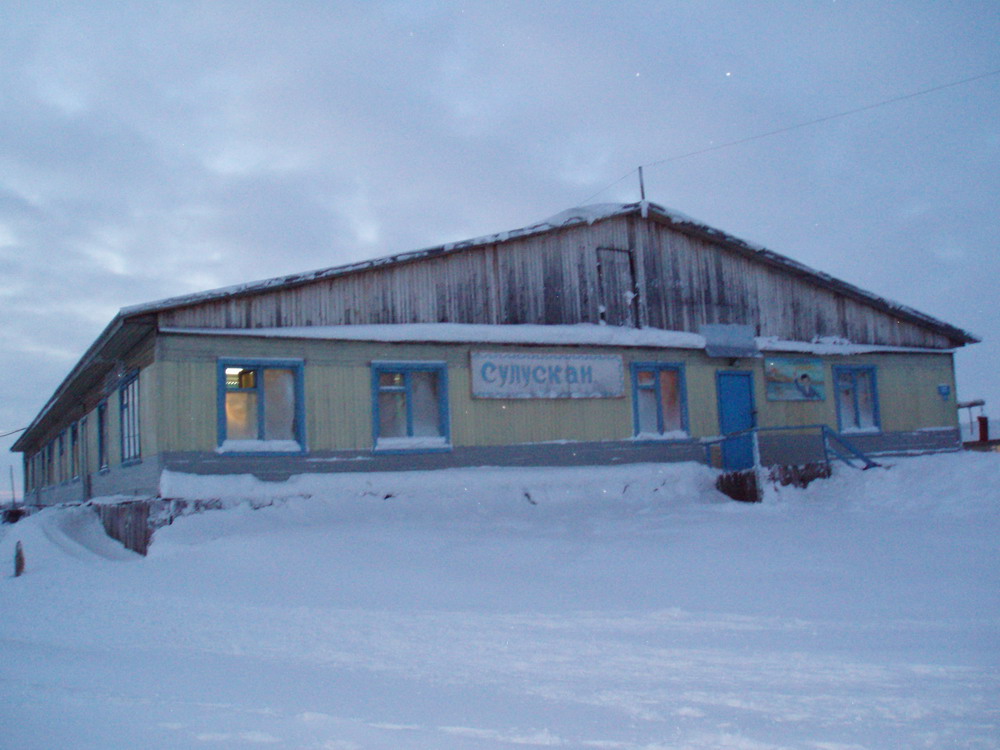
Kindergarten “Sulluskan”
As said Augusta Pavlovna, villagers their problems do not fall out of the total family list KMNS. Like the other villages, Kheta heated by coal; uses the river water, which is delivered in barrels. Message to Khatanga and other villages - the river in the navigation period, the river is, only road in the winter and all year round - air transport.
Quiet and modest lives Kheta. With hope and faith in that there are common problems of township residents, which, though not referred to herein but terrific, sooner or later will be solved.
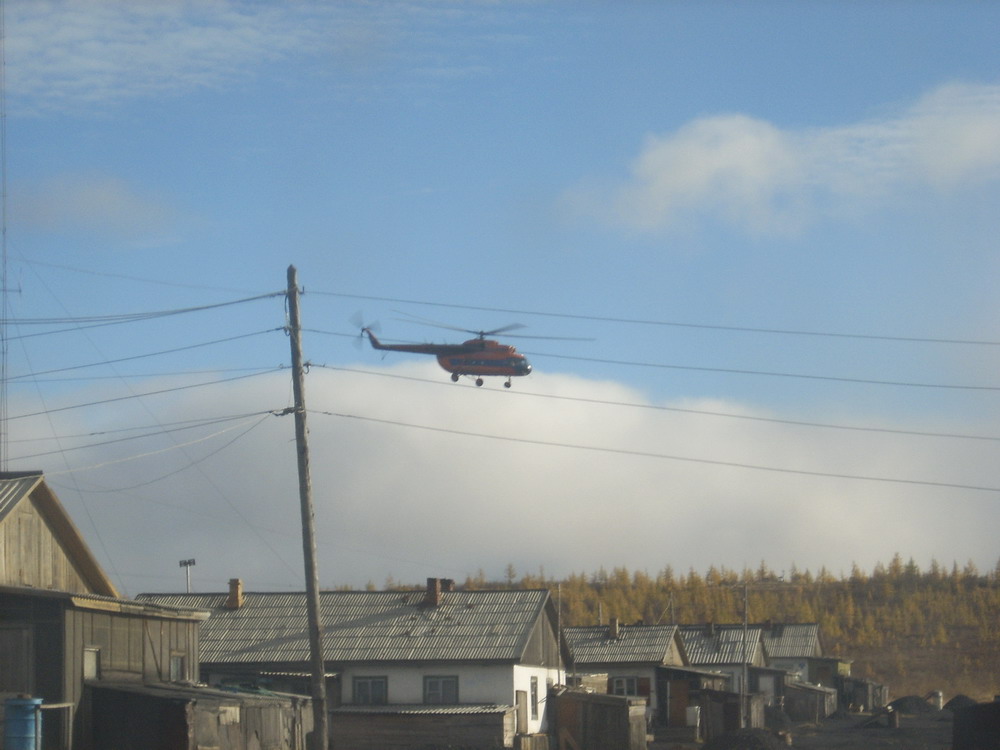
Helicopter above Kheta
02.03.2010 N.Kovalchuk
Photo by archive of the village and the author
Translate: D.A. Pozdnyakov
- Details
- Parent Category: English
- Category: Communidat
-
Also available:


- Hits: 7317
As historians say, its birth Khatanga owes much Mangazeysky sea travel. Ostrog Mangazeya, built in the early seventeenth century on the Taz River, it became a stronghold of the movement of explorers to the east. In the eighteenth century, in the lower reaches of the river Khatanga, based groups Chariton Laptev and Semyon Chelyuskin, as evidenced by the entry on the monument in the center of Khatanga. According to archive data, date of birth Khatanga village and the date of accession Khatanga the edge to the Russia is the year 1626, when was created the first Russian village in form of state Yasachnaya wintering.
Historic Landmark village is Svyto-Bogoyavlenskiy, the world's northernmost Orthodox fane. He is the successor of the very first in the Taimyr Bogoyavlenskiy church, emerged on a high promontory at the turn of the seventeenth and eighteenth centuries - the start time of the adoption of Christianity by nomadic peoples that contributed to their ethnic and cultural rapprochement with the Russian. In 2010 this temple is celebrating its 305 th anniversary.
Svyato-Bogoyavlenskiy fane
Khatanga itself - a small multi-national village with a population of about three and a half thousand people, mostly Dolgan, Russian, Ukrainians, as well as representatives of many other nations. In the other nine villages, a total population of roughly the same. This would seem a bit, but historically, that the most important in the life of Russia, Khatanga always occupied a unique place, It is the most important outpost on the northern borders of the country. She has always been and remains the capital of the eastern Taimyr.
Today Khatanga - the center of the rural settlements, completely well-appointed village with modern infrastructures. Each of the enterprises, institutions, has its glorious history of development. Apogee flourished in the years 60-80, when stabilized air service, has developed commercial shipping, earned geological expedition. Khatanga - a significant scientific and cultural and business center of East Taimyr. It held a unique biogeographical studies bring together scientists, not only Russia, but all over the world.
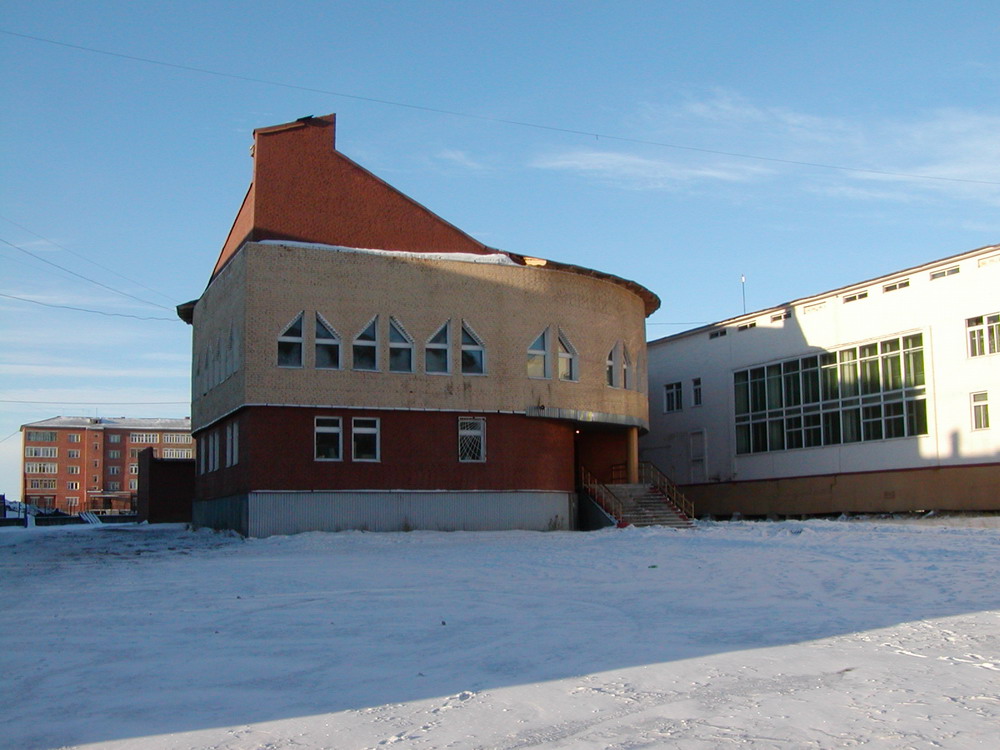
Childrens music school
Today, most large enterprises are: seaport, polar geological reconnaissance expedition, airports, housing and communal services, power plant. In Khatanga has settled in the new beautiful building Hospital and Polyclinic, work fine educational institutions, two secondary schools, including boarding school, three kindergartens, children's sports and music schools, Center for additional Education. The village operates two Sberbank, post office, Department of Electronic Communications, the oldest weather station on the Taimyr Peninsula, the establishment of hydrographic base, police station, three hotels, a chain of stores, opened recently restaurant "Khatanga".
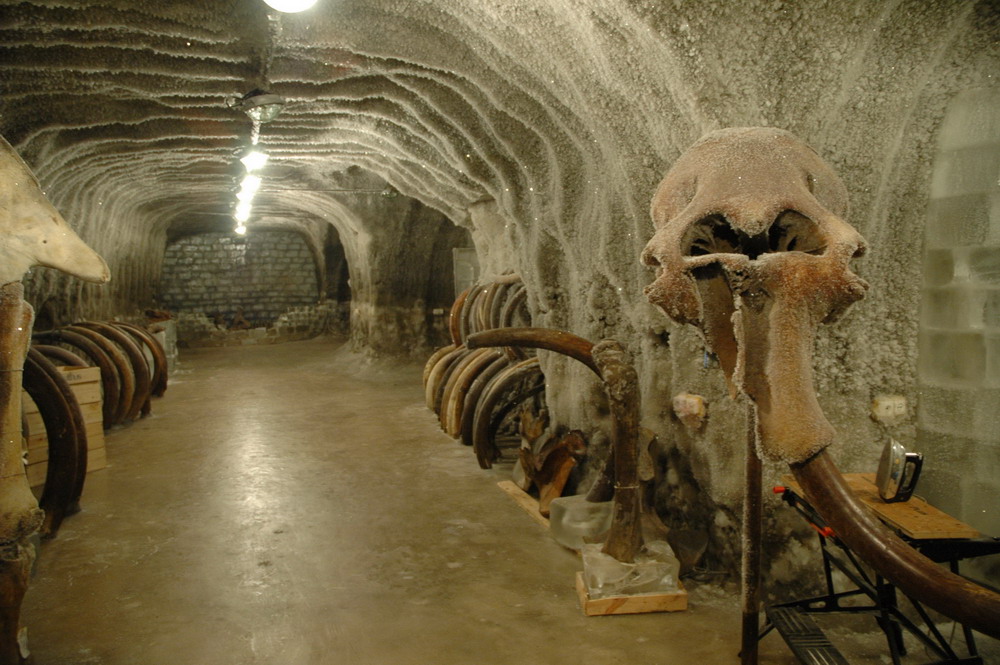
Mammoth museum
Research activities are undertaken by employees of the Taimyr Reserve. In Khatanga boasts several museums. Among them, the nature and ethnography museum, a literary museum Ogdo Aksenova, the unique cold Museum, equipped to a large ice cave. It contains unique rich collection of ancient bones and tusks of animals, including mammoths. For several years, collected the exhibits used by scientists from different countries for research. Khatanga - the main cultural center in the east of the peninsula. Powered two libraries, the House of Culture. In addition, a lot of work to preserve and promote the culture of the peoples of the North are Folk Art Center, the nature and ethnography museum, a music school. Famous for its creative ensembles "Chokurkan".
Khatanga always been a center for the development of agriculture as the population has long been engaged in aboriginal fisheries nomadic peoples of the North living here. This hunting, fishing, in Soviet times was developed reindeer and farming. Gradually nomads, become sedentary people. In Soviet times, worked successfully 9 state farms, the transformation of perestroika turned them into GOUSP. Currently, agriculture is represented artels and personal farms.
Khatanga to its historical gait, as well as district, region, country, experienced the heyday, and times are not the best for her.
In the years of perestroika, Khatanga also passed through many trials. But she withstood and survived. In this great achievement and population, and its leaders Fokin Nikolay Andreyevich, Porotov Sevostyan Nikolaevich, who devoted much effort to strengthen the region, being a few decades in senior positions. The potential of this land is inexhaustible. It should be noted that the administration of the region attaches great importance to the development of Khatanga settlement: proposed to develop a whole range of further development programs in the field of geology, agriculture, tourism and scientific research. Villagers Khatanga, as the head of the settlement, Sergei Zverev, the head of administration Natalia Klygina, confident that a great future in Khatanga - it is a reality. Let strengthened faith in gracious change, in good times and let it come to pass!
Khatanga can be of great interest for tourism, for its development. The village is already noticeable by their geographical location: takes place under the sun on the 72nd degree of north latitude, far beyond the Arctic Circle, which causes the common phenomenon for the North: polar night with northern lights and frosts to 55 degrees, the polar day and white nights, with fascinating northern sky. According to the painters attending Khatanga such paint colors such space, the diagonal arrangement of clouds, such modulations of light can only be seen here. And feel the sky. It lives, breathes. Northern dawn, of the richness of colors has no equal. Color and tone of the state is changing so fast that a person is powerless before nature palette: it is impossible to remember and to portray.
In our northern "far away" a lot of amazing things. It is unique and attractive space itself Khatanga region. His greatness, virginity, inimitable exotic north. Truly it can be felt only here, in the vast expanses of tundra, not burdened with the consequences of industrial activity. In view of landscape and ecosystem diversity Khatanga region is promising for the development of tourism environmental, ethnographic, hunting and scientific and informative nature. It is home to endemic and amazing, rare birds and animals, in particular, charming red-breasted goose, mysterious musk ox, which ranked as the contemporaries of the mammoth. Widespread as in the foreign Arctic has got ski trips, snowmobile. They are episodic in nature. Khatanga occupies a special place in the implementation of hikes on top of the Earth, showing a unique gate to the North Pole.
Product Khatanga masters
In the vastness of the tundra are working a variety of research expeditions. According to the materials of one of them and developed the above-mentioned cold Museum.
Nature gave Khatanga edge of another unique - famous Popigay astroblem, basin, located on its territory. Astrobleme relatively young, as the scientists say, her is only thirty-five million years. She is included in List of geological heritage the UNESCO.
Popigay crater, has no equal in the world. Being a very attractive target for international cooperation, this corner of the Earth has seen in his lifetime numerous expeditions and holds great promise as a research center, open and international scientific cooperation. A beautiful landscape of wildlife and socio-cognitive interest, will Popigay astroblems one of the most attractive sites for domestic and foreign tourism.
The uniqueness of Khatanga is not limited to natural boon. We have a lot of wonderful handmade objects. If anyone lucky enough to visit the Khatanga in the first half of the year, you can take the chance to see a unique building - the dam protects the ice, now unique in the world. At first glance, nothing special: a huge ice a box height of a three-story house, and thirty meters wide, with a slightly sloping side walls. Lying perpendicular to the coast, it is 230 meters in breadth river. From above- smooth snowy playground with frozen eight wooden pillars. The dam is being built annually since the late 30s. - from the time of formation of the river, and the agency is a reliable protection of vessels of the fleet during the devastating spring floating of ice.
Dam
Technology dam construction is distinctive, with a lot of professional secrets, it requires skill, experience, and most importantly - spiritual relations masters. Moreover, the work carried out in the most severe frosts: the stronger the frost, the reliable success. By March 31, the artificial iceberg ready, it blends harmoniously with the image of the coastal tout ensemble Khatanga, patiently waiting in the wings, which occurs in June. Sheltered behind the dam, "like a stone wall" the ships are in the cozy backwater, watching silently, “a fuss” the ice fields near deadpan obstacles. In summer, at one point breaking in impressive size ice blocks. Entrained powerful over river, they are making three hundred km journey to the Laptev Sea. Short Century dam active life, but it is enough to justify its purpose.
And, finally, how not to admire the world's northernmost Orthodox church, First Bogoyavlenskiy Church on the shores of the Khatanga arose at the turn of the seventeenth-eighteenth centuries. She became the northernmost and the first on the Taimyr Peninsula. Only the great river and remembers the exact date of his birth. The first mention of the church dates to 1705. The temple was the most revered building in the village and has served the people of 200 years. Since the inception of the temple in Khatanga service made hieromonks Turukhansk Svyato-Troickiy Monastery. Hieromonks passed more than a thousand kilometers of the heavy way, within a few weeks they come every year for Christmas, and remained there until Holy Easter, then in the same way, for another icebound rivers returned to their abode. In the late nineteenth century, the clergy began to be a permanent service. The second church was built in Khatanga in the early twentieth century, but has served only a few decades, at the end of the seventies was destroyed by atheists. Years passed. Difficult time the state changes, throwing, insecurity and demanded the release and spiritual support. At the initiative of the district administration head Nikolai Fokin in the early nineties it laid the foundation of a new church at the highest and most beautiful place on the river bank. Active construction was carried out at the beginning of this millennium. Renewed Svyato-Bogoyavlenskiy temple was a gift to us in the 375th anniversary of Khatanga. August 19, 2001 to the great feast of the Transfiguration of the Lord , he was consecrated, Eminence Archbishop of Krasnoyarsk and Yenisei Archbishop Anthony. This year, the temple is celebrating its 305 th anniversary.
Great everything, created here by their work people. Still, the main wealth of Khatanga - people. All these ingredients have formed an opinion of one of the foreign guests visiting our region. He said that, if Jesus come down from heaven to earth, the first place that he visits, will Khatanga. People, motherland of which - the Taimyr and those arrived for a short time, have found a second motherland here. Sincerity, warmth, hospitality for centuries inherent to northerners, were enduring values in our difficult days. And it distinguishes the people living here from the "mainland people", plunged into the harsh, uncompromising world of the market. Bathe after many months of hard employment in the conditions become the norm competition and hard relations in a simple warm atmosphere of goodwill and selflessness, relax your soul - it's not so little in our age of rapid technological progress and the inanimate computer technology.
Villagers Khatanga confidently call: See and feel! Hurry!
21.06.2010 N.Kovalchuk
Translate: D.A. Pozdnyakov
- Details
- Parent Category: English
- Category: Communidat
-
Also available:


- Hits: 10066
About three hundred kilometers to the north of the administrative center and a few hundred from the nearest village Novorybnaya, on the right bank of the Khatanga, where the river widens in the Khatanga Gulf, located Syndassko. The inhabitants of this village in the arsenal of jokes, and there is this: "I will go on vacation to the south ... in Novorybnuyu". In the "business card" Syndassko can add those details that he is almost at the seashore, in any case, the water in the bay salty, not suitable for drinking. To stock up on life-giving moisture, need to get on the lake stretching several kilometers beyond the village, chop pieces of ice, and in the summer just to get water. As said Head of the settlement of the territorial department of Anna Bettu, supply of drinking water carries the tractor, brand new, recently obtained in exchange of your old.
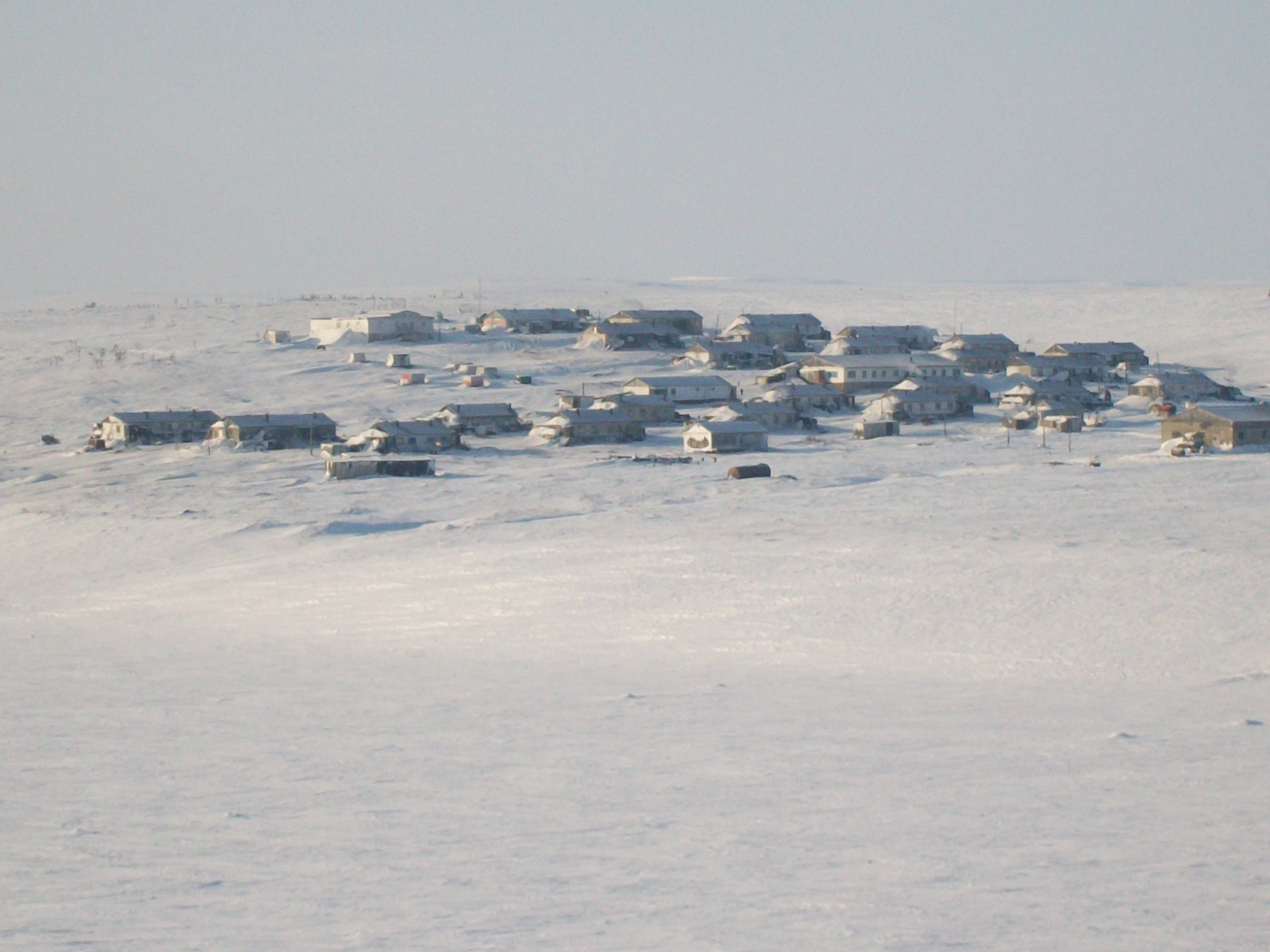
View of the Syndassko
The business card village is appropriate and Coal Mountain - "urduk kai", as the villagers call her. If you go to any transport in Syndassko – snowmobile, ship or helicopter silhouette "urduk kai" is the first, and a sure sign of approaching of the village. And she Coal Mountain has long been a source of fuel, heat for the nomadic population. When it started to mine and use coal, no one remembers. But in household books Cargo-Kyuelskogo Council of 1931, which Syndassko included, under "profession" next to some surnames means "uglevoz". The ability of the local coal mining, according to the villagers, not inferior in quality Kotuiskaya, and today is for villagers Syndassko relevance value.
Based on the collected historical data, founding date Syndassko - 1931 and the date of the celebration of the Day of the village - of April, conjunction with the Day of Reindeer. While the old-timers argue that the population, the farms Syndassko formed much earlier, but specific information about this already eroded from memory. Status village he got when people started to move to a sedentary lifestyle.
Residents Syndassko very fond of his village. At the present time, they collected information about its history, underway the chronicle, tells the story of the tragic and happy page, small motherland.
The most difficult moments in the history of Syndassko - repression of the thirties and during World War II. In those years, recorded in the "Annals", people have lived for centuries, engaged in aboriginal traditional occupations. Women smoking a long pipe (nagsa), started doing buckskin, Camus, sewed fur clothing, footwear, smashed accumulated over the winter deer bone, cooked them, extracting bone fat, drying and smoking cut into strips the meat - prepared yukola, and smoked peritoneum and backs fish. Men fished, engaged in hunting, grazed deer , harvested fin, cut firewood, prepared and engaged in repair of reindeer sleds, sleighs, beams. Were in the village and shamans. lived together, helping each other, as well as the sick, orphans, the elderly. It was written the precepts of their fathers and grandfathers. Gradually, people became accustomed to life in the new conditions of Soviet power. Only in the heart of the older generation remained eternal sadness: repression, dispossession was the great tragedy of a small village. Almost all the heads of wealthy families, were taken "somewhere." Not all of them were later exonerated.
The Great Patriotic War became exorbitant test as for the whole country, and the residents of the village. Hungry. Cold, old people remember, they lived and worked very hard. Tried for front, for the Victory. For their needs were not allowed to score a single deer. Many villagers went to the front. Not all of them have returned. "Chronicle" of the village, can name all the names.
Countrymen are stored in memory and in the pages of recorded history and events. As the years passed, life is gradually improving. People, in general, led a nomadic life, living in tents in the summer, winter - in the beams. In the 40s began to build of capital houses on the basis of log cabins, imported from places of work expedition - from the Cape of Elijah and Kozhevnikovo village.
Conducted a large cultural and educational work. Young people willingly went to school kolkhoz universal education by preparing collective training. 1938 is listed in the "Chronicles" as the year of the formation of collective farm named after Kalinin, thundered subsequently their achievements in the whole district. Chairman of the Board in the 40s Chuprin Vlas Petrovich and chairman, head of the farm for more than 12 years Kirgizov Alex Stepanovich - these and many names of leaders, leaders of manufacture forever imprinted on paper and in the memory of fellow countrymen. As pages of the history of state-farm movement - on the basis of the collective farm was later established farm "Arctic". The period of its activity - is the years of the maximum prosperity of the village.
Modern Syndassko in infrastructure is no different from their counterparts - are available and operate all the companies and institutions. The population is mainly engaged in traditional activities.
Deers
Syndassko as Popigay and Novorybnaya - settlement of reindeer breeders. Nomadic families - came from these villages. These people, are in love with the tundra, working without days off and vacations in our usual sense, they not think and do not want a different life. They value freedom above all, the beauty of space and privacy, attraction native land. There are a few dates in the year when the tundra people hurry home to the village, taking the National Party Supplies: Fisherman's Day, the Day of the village and the Reindeer Herder's Day.
The most colorful and large-scale national holiday - Day of the Reindeer, which are prepared carefully, long and carried out in accordance with the established tradition Dolgan culture. In the three distant, relatively isolated settlements fuller and brighter preserved traditions, customs, national color Dolgan people's way of life and, of course, language. If, say, in Kresty, talking more in Russian, here speak Dolgan language. One of the goals of national holidays is that children are actively participating in the festivities, do not forget their language, culture and, therefore, will be to maintain and develop it.
That settlement Syndassko won the title of the capital of the most important holiday of northerners. It has a little more than forty houses. During holidays, the whole village preens: place of sports competitions are marked with colored flags and balloons, reindeer sleds and holidays plague decorated with the most elaborate ornament, the villagers put on their most festive national dress, preparing delicious northern dishes. In the holidays are involved not only the inhabitants of the village, there are more than five hundred, and numerous guests. The celebration takes place with great success.
Syndassko famous skilful bone carver. Although their direction is described as Yakut school still countrymen believe that there is a special artistic taste in the art of bone carving, own school Syndassko. Highly artistic work of masters from mammoth ivory has repeatedly and successfully exhibited at the district, regional and international exhibitions.
Actively working in the village and the MOC. Together with the village administration, the youth participating in grant programs. In 2009, as part of the mini-project "Streets of our dreams" in Syndassko forces youth Centre works on an accomplishment of streets. In particular, landscaped playground, made flowerbed, the big picture, which is placed on the outside wall of SDK.
Within the framework of the regional target program "Indigenous People, 2009-2011" also implemented two projects " Flourish our village" and "Call of the past." As a result of the development grants built two beams, hosted a of local lore mini-museum. Acquisition of materials for the manufacture of two tents and national products, food, clothing, sports equipment. The project activities were carried out in engaging young people in the village, to life of reindeer herders. Tundra-people shared with the younger generation, of manufacturing and ethno-cultural experience.
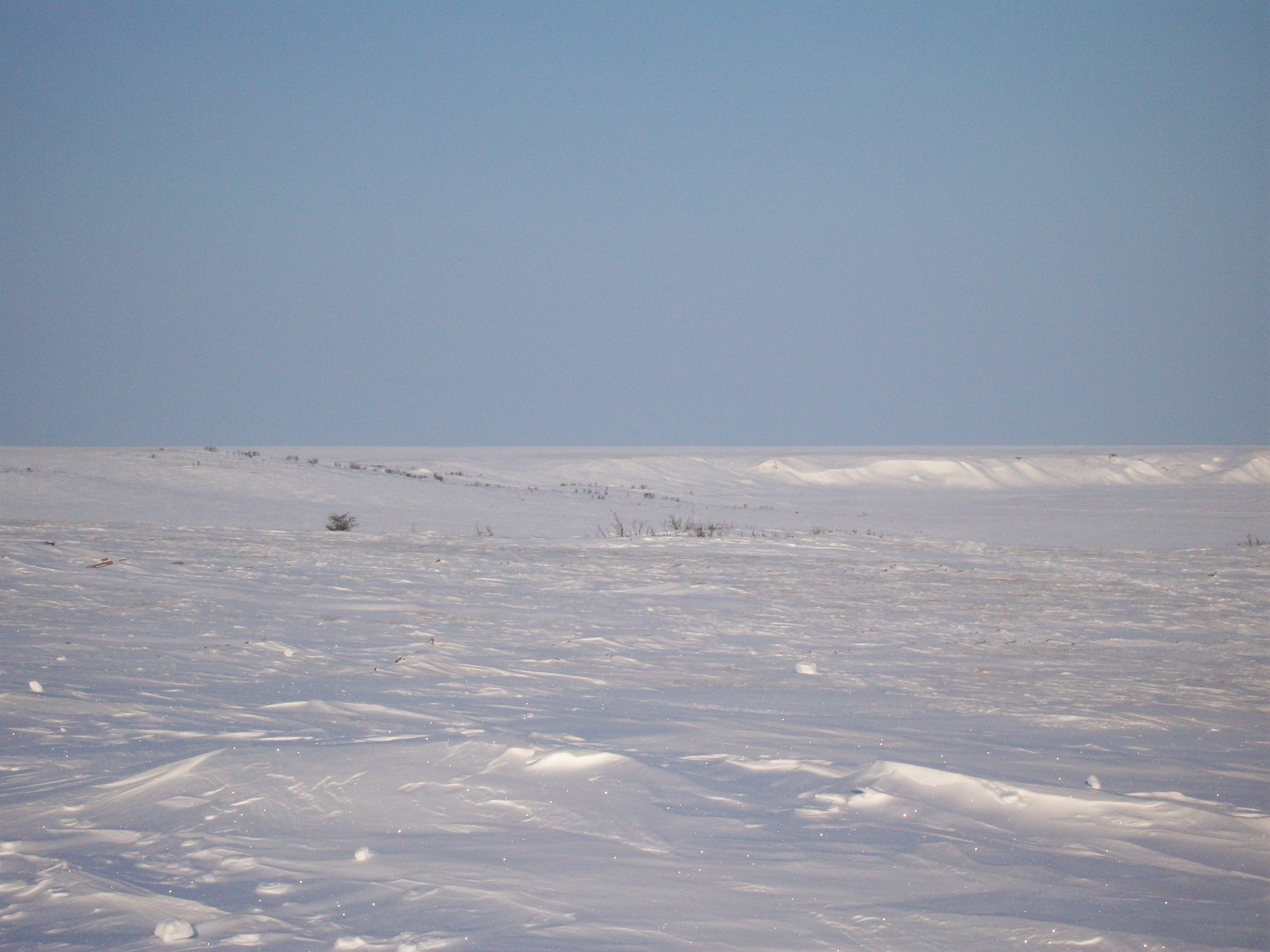
Tundra
It is pleasant to note that the head of the territorial department of the village Syndassko Bettu Anna Ilinichna recognized as the best director of 2009 in the category "Village head".
2010 N.Kovalchuk
Translate: D.A. Pozdnyakov
- Details
- Parent Category: English
- Category: Communidat
-
Also available:


- Hits: 5943
Popigay rural settlement located on the banks of the same river in the north-east of Taimyr, almost on the border with Yakutia. This village belongs to the group of "northern bush" has its own special history. Day of its occurrence – May 31,1931. But the fact of the birth of the village happened at another point : It was founded about two hundred kilometers from the location of the modern Popigay upstream. From the district center of the village was located at a distance of 290 kilometers, if you count in the air and 700 kilometers-ah, if reached by water.
Relocation was not someone's whim or caprice: reasons for the village transfer they were of a serious nature. Firstly, due to transport problems circuit - despite the fact that it was located on a navigable river, however, it was in an inaccessible place for river vessels, which it was difficult and dangerous to reach village even at big water. Providing food and other necessities, it was not possible. And air transport has always been very expensive. Secondly, and most importantly - this is big water, the case during the spring snowmelt and ice drift, inflicted a crushing blow to the village literally wiping out coastal home. And those that were located away from the coast has always been flooded with water. Of course, many villagers were suddenly deprived of their property and the property of all, and those whose houses were partially flooded, a large proportion of the property fell into disrepair. To a greater or lesser extent, it happened every year.
Guidelines Khatanga region, it was decided to transfer village downstream river, where for several years on the high bank of the same river was purposefully building the future of the village. After another flood Old Popigay its residents were evacuated urgently to a new residence. "Great Migration" villagers happened in the early eighties of the last century and was not in the best event in the life of the villagers, and although everyone was clear this real need. Many took this as a real tragedy, and finally, some elderly people in general could not part with his native village, and stayed to live out in the Old Popigay as since then the villagers began to call his native village.
People can understand that it is difficult to permanently leave their homes, where "was born and was baptized", where he spent all your life. In addition, very favorable was the nature. Forest, rich in mushrooms, berries, and just - aesthetically pleasing beauty. It's hard to part with those benefits. I can not mention the events of the prehistoric ago. It is a very significant, interesting, and most unique feature of the location of the village. It is located on the territory of the famous Popigay basin or astrobleme, as it is called scientists, which translated from Greek means "star wound." Popigay astrobleme - a unique geological monument of nature, the most amazing asteroid crater on the planet. "Star wound" Earth, after explosion fallen giant asteroid was more than a hundred kilometers in diameter and a half to two kilometers deep. According to research, the collision of two celestial bodies was about 35 million years ago. Popigay astrobleme It is the "youngest". Therefore, exposure of this relatively young asteroid crater is very attractive to scientists around the world. Russian scientists have gathered a rich collection of geological specimens, found in the valley, found valuable paleontological exhibits. The expedition that worked there, filmed movie. Often the conductors of scientists on the territory of the basin were locals. Among them Uksusnikov Constantine, worker FSI "Reserve" Taimyr ", born to the Popigay.
Recall one circumstance, the pride of not only residents Popigaya, but all of Taimyr: on the initiative of famous Novosibirsk scientist Sergey Vishnevsky Popigay astrobleme included in the UNESCO list of the geological heritage and is on a par with such famous sites of global importance, such as Yellowstone National Park, Colorado canyon or the Galapagos Islands.
Until now preserved scenery, showing the traces of the famous cosmic accident.
The generous nature of the southern part of the basin has led not only to emotional recovery, there are purely practical side of the coin. The fact that the hunting here has its own specifics, due to the presence of the forest. It requires special sledges, beams - smaller sizes able to maneuver between the trees. Unfettered expanses of tundra, where the new settlement, need quite different options for vehicles and housing. Others are the secrets and art of hunting. All this had to comprehend villagers Popigay in a new place. In a new place is another approach to the problem of fuel: If in the Old Popigay had the opportunity, if necessary, to use wood, abundance of fin for heating, here, in the treeless terrain, this is not possible, one hope for imported coal.
With of the moment the relocation it has been nearly 30 years. For the younger generation, present Popigaj - native village, and young people, of course, free from the pangs of nostalgia. In Old Popigay lived for a long time remaining residents, supported by relatives, geologists, members of other expeditions.
Popigaj
As regards the chronology of events, the first organ of the Soviet government in the village began in 1931 Popigay generic Council, renamed later in a nomadic. In 1935, the village had a population of 300 people, including 160 men and 140 women. The first farm bore Stalin's name and was formed in 1938, headed by Chairman Yegor Popov. At the end of 1961 the farm was renamed into kolkhoz XX !! (22) Congress of the CPSU. Leading industries – fur production and reindeer.
Home of the sixties is characterized by the development of active construction. In the village there are: the club with a library, a kindergarten, a sauna, a primary school, a small hospital, a power plant and houses.
In 1975, when the government decided on the reorganization of agriculture. Popigay separation farm "Arctic" was established on the basis of the collective farm. The central manor was in Syndassko. The main activity is reindeer. The names of fellow countrymen, collective and state employees ,included in the annals of the history of the village. This reindeer, awarded government awards Chuprin A.S. and Bolshakov S.N. foremost hunting Chuprin N.D, Zharkov N.M, Chuprin N.M .
Remember villagers, and fellow-soldiers. This Nikita Zharkov, who died in 1944, buried in Karelia; Alexei Popov, missing person; Athanasius Lacherman - returning from the war, worked as a district police officer in Norilsk, died in 1990.
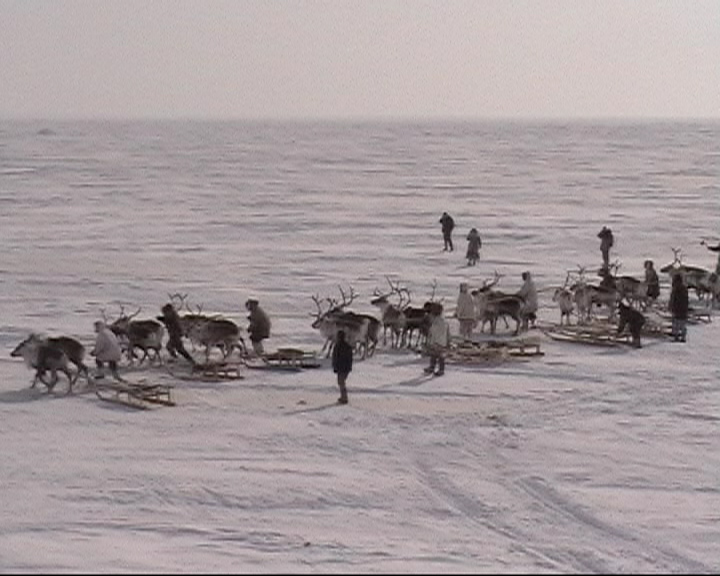
At the start
Modern Popigay remains one of the three reindeer village in the rural settlement Khatanga. It is not surprising that the Reindeer Herder's Day - the most important holiday of the villagers. The population of a little more than three hundred people, almost all - Dolgan. The village has all the necessary infrastructure, including DES, elementary school, FAP, KFOR, post office, shop. Most of the population is a traditional way of life, that is nomadic. Some are worked in the community "Popigay", created in 2003, others - in the cooperative "Tundra". All the sadness and joy, says the head of the territorial department of the village Kudryakova Lyubov, do not differ from the sorrows, joys and hopes of the inhabitants of other villages Dolgan. The main thing, she says, we live together, help each other - one of the principles Popigay villagers.
14.04.2010 N.Kovalchuk
Translate: D.A. Pozdnyakov
- Details
- Parent Category: English
- Category: Communidat
-
Also available:


- Hits: 9085
Novorybnaya - one of the three villages of the northern reindeer Khatanga settlement, the largest of them in the number of inhabitants (627 people). live here, mainly Dolgan peoples, Nganasan peoples, Russian and some representatives of other nationalities. The settlement is similar to the others, and yet, in some ways unique, has its own characteristics that are unique to him. Nature here is very different from the south Khatanga settlement. What the eye is allowed to see, the open space. The natives of the northern villages are confident that this expanse is nothing to prevent a complete fresh breath, free calisthenics on the vast tundra and it is - the best that can be in the world.
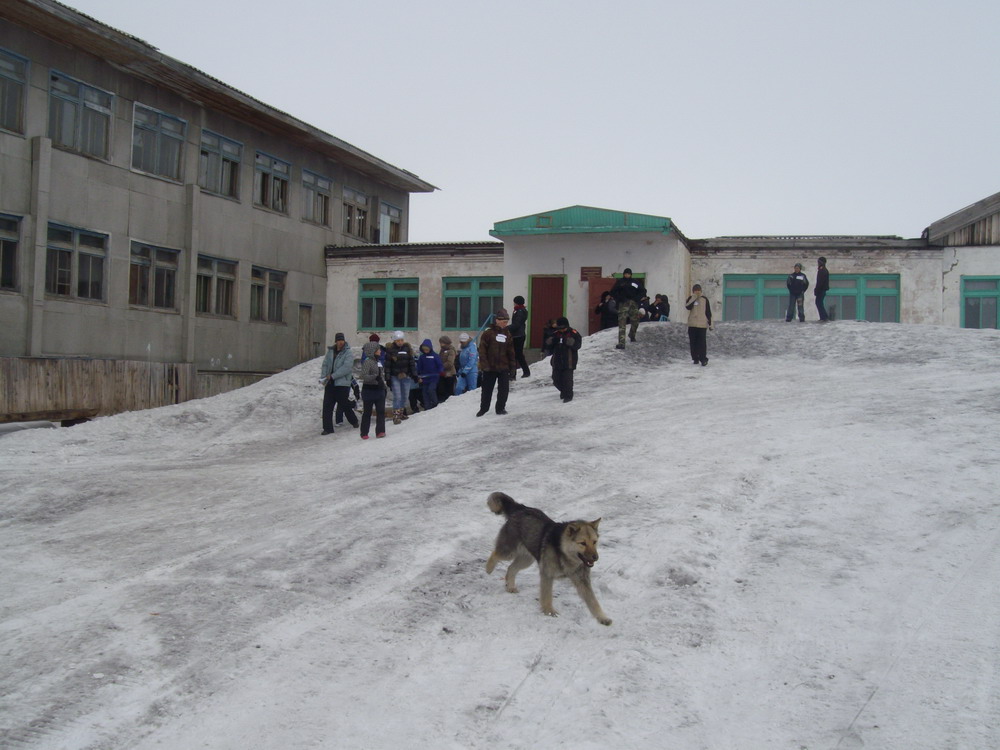
In the schoolyard village novorybnaya
Specialist of the territorial department Elena Popova proudly talks about the responsiveness of their countrymen. And that the youth organization of the village - One of the most sports in village. With children actively engaged in a physical education teacher, professional athlete, who achieved high results in the north all-around Konstantin Fomin. Athletes village Novorybnaya repeatedly were participants regional competitions, zonal competitions and fees. And love village Novorybnaya football is known in all village. Young people have prepared with their own hands under the playground football field and play outdoors almost all year round.
Another village is famous passion women houseplants they are bred in large numbers and in every home. Home lover and connoisseur of green indoor world, head of library- Praskovya Chardu. Villagers very fond of his native village store and revere its history. Stories and memories of his countrymen Praskovya Ivanovna gathered together in the pages of "Chronicles village". which is systematically updated with new information as last time, and about today.
The village is located on the high right bank of the Khatanga 180 kilometers from the administrative center down the river. From the pages of “The chronicle” can learn, that the left bank of the famous places rich, spring fishing. Of the population live here for centuries engaged in traditional occupations - people fished, hunted, herded reindeer. lived in harmony with nature and with themselves, not forgetting the wonderful tradition Dolgan - comply with the customs and traditions of their ancestors. Later, with the Dolgan communion to the Orthodox faith, have become celebrated and the main Orthodox holidays. From generation to generation passed on information about national traditions, as well as the folklore heritage - folk tales, legends, stories, proverbs, superstitions. With the emergence of Dolgan writing, one of the founder of which she was the famous poet Dolgan Aksenova Evdokia Yegorovna, wealth national epic written and published.
In the lower reaches of the river people roamed, justified the camp. January 23, 1931 was established Bludnovsky nomadic Council. Name comes from the name of the Prodigal river ,Khatanga inflows. This date is considered the date of birth of the village Novorybnaya. The first chairman Bludnovsky nomadic Council became Antonov Mikhey Satipatrovich - assistant skipper, he worked on boats plying between Kosist and Khatanga, driven ships on the fairway. According to “The chronicle” Antonov Mikhey was determined the place of the current location of the village Novorybnaya.
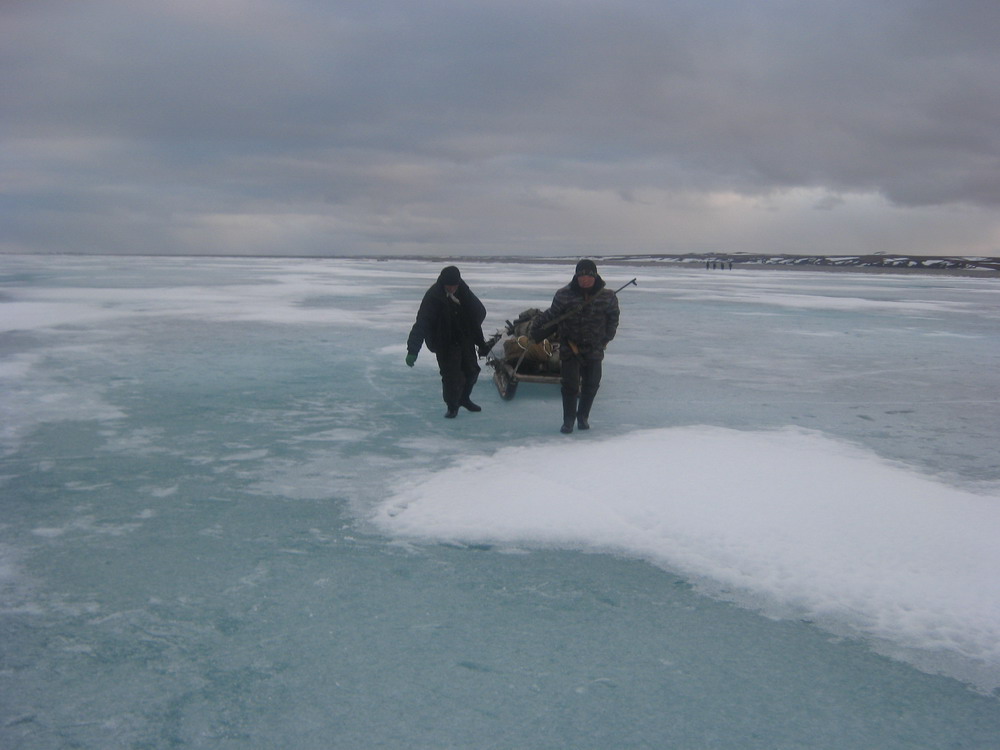
Iin the Tundra
Among reindeer herders many families, the nomadic, including young families. All year round they are in the tundra. Come to the village by necessity for food, medical care, or simply to visit relatives. if possible try to get to the most important, the most colorful holiday - Day of Reindeer. In the village is informed, in the department for the development of settlements settlement administration organized and for seven years work two agricultural enterprises : commercial-fishing cooperative "Novorybnaya" and co-operative "Nasco". In addition to farms, the village has all the necessary for the sustenance of enterprises and organizations education, health, culture, trade and communications. In Novorybnoy it has a secondary school, one in the entire northern bush. Kindergarten, which provides places, almost all comers. Country House culture actively working library. Villagers kingdom books chosen for communication. here throughout the year are held interesting educational activities, theme nights , various intellectual competitions.
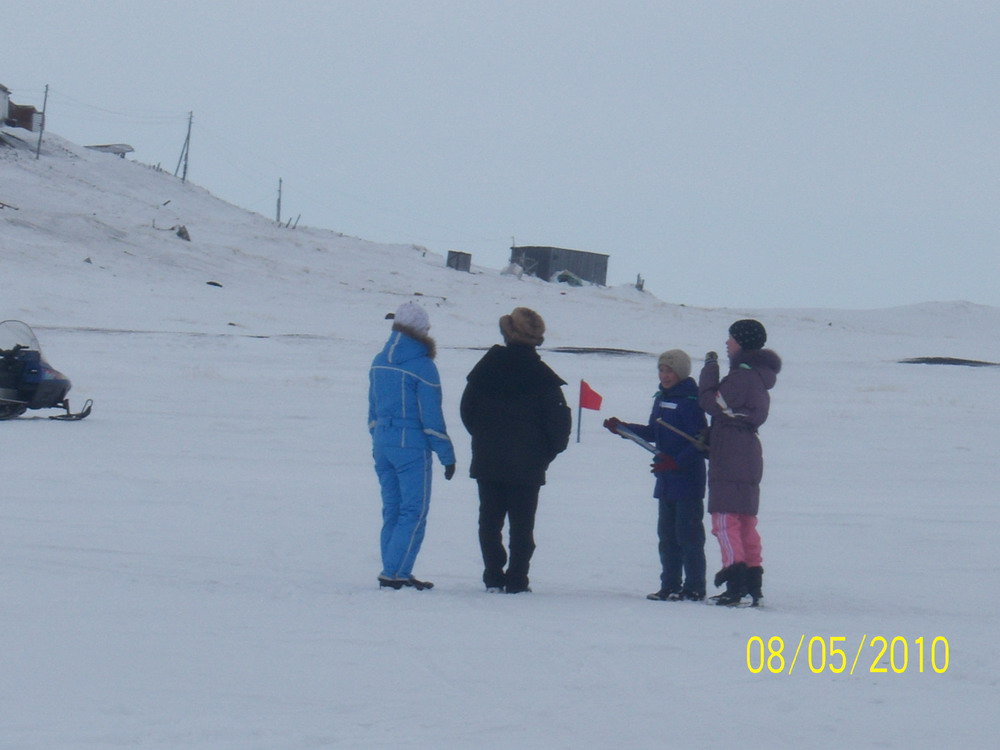
Military- sports game “Zarnitca”
In the village there is FAPs, with beds for inpatients. Is there a mandatory component of the infrastructure of the diesel power plant provides electricity to the village, a post office.
Novorybnaya - settlement of long-livers. Age most of them, the most kind and wonderful Antonova Anna Petrovna. At the beginning of the last century in the northern territories were not kept meticulous records of birth dates, therefore she age listed about a hundred years, villagers say that in fact, she is already more than a century. They are proud of their famous countrywoman. Anna Petrovna is not only a witness to the events of the century, she saved the true soul of the people, its spiritual values.
Novorybnaya - the birthplace of many creative individuals, Dolgan, possessing the gift of an exquisite ivory carving embroidery, production of clothing, literary talent. The villagers are particularly proud of the fact that lived here for several years and worked as a well-known poet Ogdo Aksenova, as evidenced by a plaque on the wall of the rural house of culture. Evdokia Egorovna not only lived in the village, she was active, multipurpose literary activity. Much time is spent in the tundra, communicate with fellow countrymen, he gathered and left a priceless artistic heritage, which enriched not only the culture of a small Dolgan people, but also is a gem in the treasury of world culture.
24.06.2010 N.Kovalchuk
Translate: D.A. Pozdnyakov
- Details
- Parent Category: English
- Category: Communidat
-
Also available:


- Hits: 4922
Kresty. When you hear the name of the village for the first time, you feel a little uncomfortable. With a very grim notion it is associated. But when confronted with it every day, and even more so if your own home – Kresty then you can hear it even music. The village has existed since April 1924, When by the decision of the Committee of the North opened factory State trade in the village Kresty. But the legend, passed from mouth to mouth, from generation to generation, indicating a more advanced age population. It is said that even in the eighteenth century by the cross “At the mouth of the Kheta” had the cabin Krestovskaya. which became a distant precursor of modern village Kresty.
View of the Kresty
This modest village is closest, just twenty kilometers from the village of Khatanga upstream of the same river. More romantic place of location the village is hard to find. Imagine a point on the globe, or conditional on the earth's surface, where it joins two large northern rivers - obstinate, with Putoransky mountain source Kotuj and low-speed obliging Kheta. Rivers do not flow into one another, they simply connect your streams. Point of contact of the rivers, gives birth the beginning of a powerful full-flowing river of East Taimyr - Khatanga. In fact, this is not the point, and very impressive extensive water area. In one version of a unique "Cross", formed the Triple Alliance of the rivers, the village owes its name. Connecting, rivers lose one shore and the other two far away recede from each other. So Khatanga river ,at its source - not a trickle, and full, formed river.
Slender streets with small houses lined up in a row on a high steep bank, visible from afar and fishermen, scurrying about in boats on the rivers, and drivers make their way through the winter road, and especially the pilots, guides his aircraft on the Khatanga airfield. The village serves as reference point for large riverboats, performing the role of honorary lighthouse.
View of the Kresty
All patriotism and love for his village, villagers Kresty embodied in the album, prepared for the 85th anniversary village Kresty. The chronicle tells not only about the events, but transmit to future generations respect the names villagers Kresty. This is confirmed by the very title of the album - "No history without names." The development of the village in the Soviet and post-Soviet years occurred under the scheme, common to many villages. Collectivization, the struggle for the establishment of Soviet power, the first farm, the struggle for the universal elimination of illiteracy, war years, the Stalin collective farm, renamed over time in the collective farm "Victory", state farm "Soviet Taimyr" post-perestroika years - it's all the same Kresty.
The collectivization took place difficult to bloodshed. In 1932, was brutally murdered by the head factories state trading communist M.P Rogoza. Imprinted in the album and the name of the chairman of the first collective farm dated 1938 - Mikhailov Mikhail Anufrievich, His successor from 1940 Yamkin Konstantin Mikhailovich. The war years, villagers Kresty worried hard, together with the Taimyr, with the entire country. Strict discipline, increased obligations production indicators, working in two shifts, malnutrition - all life is subordinated to slogan: "Everything for the front, everything - to win."
Villagers Kresty they saw off fellow to the front and waited for them back. This hunter-sniper Chuprin Konstantin Ivanovich. About him say that nature has given his watchful eye and keen sense of the hunter, northerly winds and frosts, tempered him. At the front him useful innate and acquired qualities, helped to perform the most important assignments. Awards are not given in vain. One of them - the Order of the Red Star, found the owner only in 1970.
As the villagers say, the village began to develop rapidly in the years after the war, having the status of a collective farm named after Stalin. Economic activities on the farm has been diversified : deer breeding, fishing, trade furs, animal breeding, breeding of animals in the cage. At the same time the number of reindeer was 12 thousand heads, fish catch - 1200 quintals a year.
The collective farm "Victory", in which it was eventually renamed already in the fifties of the last century was the title of a millionaire on the amount of income. In 1969, there were twenty-production teams on the farm : deer breeding, fishing, hunting and business, one farm for animals, numbering 120 animals blue arctic fox. There was also a farm for cows, which is not typical for the North. Despite the harsh climate of the Arctic, Cows in the amount of fifteen heads felt great. Presumably, due to the warm relations, pastoralists, attentive care and carefully harvested forage. In any case, was a lot of milk, it enough and children, and adults. Particular, production indicators created on the basis of the collective farm "Victory" farm "Soviet Taimyr".
The most important dignity village are people. Consistently over the past years restored the names of the leaders of the village, names of the best hunters, fishermen, reindeer herders, the best workers, associates in the field of education, culture, health care, workers in other areas. Each villager can look memorable album, on which pages found with the names of all the fellow countrymen who want to remember.
A special place in the grateful memory of the villagers took Falkova Christine Nikolaevna, still alive and living in Khatanga. She began working as cultural activities organizers red tent. In his career she rose, to the head of the farm "Soviet Taimyr" who successfully headed for many years. She It has a lot of rewards, including the title of "Honorary Citizen of Taimyr". She brought up eight children.
Kresty today there are only fifty-seven houses, residential and office. And its population – 330 peoples. As in all northern settlements, people here live as one family, each imbued with sorrows and joys neighbor. And everyone, if necessary, ready to come to the aid of fellow countryman.
View of the Kresty
Naturally, as in the whole country over the past two decades, life has changed. From the former glory of the farm-millionaire was gone. Diversified economy, high production figures - a history to be proud of. For many years, people learn to live in the new market conditions. The employment problem - it is well known. Those who have a permanent job, working in the public sector, in the MUP "utilities". Part of the population are nomadic. Nomadic people engaged in traditional crafts - hunting, fishing. But the difficulties with sales market remains on the agenda.
The villagers are happy to remember the events of two years ago, when, half of the village worked as a team. Then actively proved himself public youth center “Erebil” (“Hope”) : guys have become parties to the regional program "Social Partnership for Development". According to the draft bulk of the work dealt with the repair of residential buildings. As noted by the head of the territorial department of Margarita Batagai, the initiative has picked up all the unemployed population, worked with great enthusiasm. All - and who worked, worked and for whom - were a real pleasure to participate in the project.
Especially happy pensioners, lonely, vulnerable villagers. Has been repaired, especially their housing. They also received assistance in screening coal (This is very important, because the village is heated in such a fuel, and sift it - not such an easy job). The boys brought the elderly pensioners drinking water. Features water supply - problem, as the village has no running water, so take water from the river and delivered to homes.
View of the river
Villagers living in the old housing stock dating back to Soviet times. And hope that the regional program, providing for the construction of housing in rural areas, will become a reality, and the village will update in the coming years. t should be noted that the shortage of housing in a residential area residents Kresty do not experience - enough for everyone. This is one of the few villages where not on the agenda of the housing problem.
All northern villages, they look alike. And yet they are different.
Proximity Kresty to Khatanga, administrative center is definitely affected. Not all the children know the native Dolgan language, says the head of the territorial department of the village Margarita Batagai, because the younger generation communicates primarily in Russian. Adults try to change the situation: live and Dolgan language and folk songs.
Traditional favorite classes Dolgan - sewing of clothing, footwear, art beadwork, manufacture of articles of fur is still very popular among women in Kresty, although not on the same scale as in white years. However, national traditions are not lost their importance, organically woven into contemporary designs life. There are still masters, impressing his original art. Special prestige and honor give fellow veterans art work – Fedoseeva Evdokia Egorovna and Molchanova Evdokia Innokentevna. But her skills and fantasies they are not inferior and embroiderers with less experience - Augusta Kozhevnikova, Batagai Maria, Natalia Mikhailova,Tamara Chardu and others.
Margarita Alekseevna sure that young people need to cultivate a love for their native language, culture, learning all the tricks of survival in the tundra. Young people can still learn from experienced people, directly under natural conditions. As recognized by the village head, her dream - to buy a herd of several hundred heads of deer and really interested youth, teach reindeer, with the acquisition of young people in the age-old experience of national activities.
17.02.2010 N.Kovalchuk
Translate: D.A. Pozdnyakov
- Details
- Parent Category: English
- Category: Communidat
-
Also available:


- Hits: 4688
In Khatanga long time lived and worked enamored in Arctic human, a wonderful researcher Khatanga stories Vladilen Troickiy. He is the author of the famous book "Khatanga", Khatanga peoples grateful for the opportunity to address this edition again and again, taking, priceless nuggets of historical events names, dates. Vladilen Aleksandrovich tells about the assumptions that led to the emergence of the village Kayak. In 1935, rafters brought the forest in Khatanga, from Kotuy. They brought samples of high quality coal, which was sent to Moscow for examination.
It should be noted that the Kayak, often this village is still called by name Kotuy, by name of the same river, and then the mine, stands, feature out in the list of villages, Khatanga villager and is the youngest. This miner settlement. We can say that the history of Kayak - is the story coal mine of "Kotuy". The mine, at which increased village, fully functioning from 1947. But that was in the previous years? More about this later.
Discussion rationality opening of a new coalpit,2008
Speaking about this unique village, we can not ignore the peculiarities of its geography. It is located south of the Khatanga, 90 kilometers upstream of the aforementioned Kotuy. The source of beautiful,Shrew mountain river hiding away in the foothills Putoransky plateau. The river flows through the amazing beauty of the canyons, overcoming multiple thresholds, collects water from numerous tributaries. At the foot of Kayak, located on the steep right bank - this is a powerful full-flowing river. Assertive Kotuy before than to unite its water with quiet waters flat Kheta, It passes through another beautiful canyon, educated, rock walls his two cliffs. This section of the river, several kilometers long, popularly known as Kotuy pipe and very popular among nature lovers.
The village itself, this corner of "Taimyr Switzerland" gained fame Northern Riviera - before, he picturesque, mysterious and attractive, both in winter and in summer. When the mine people were able to create for themselves a decent working conditions and a life, build a beautiful mining town. In addition to housing, here and now have all the necessary - boiler room, gym in a wonderful school, a library, a health center, a communications center, dining, home culture , shop, bath. The romantic image of the village, complement the high wooden bridges and transitions original monument - small train, in due time to give all their strength to perform productive tasks for the development of electric power. and now - one of the main attractions of the village.
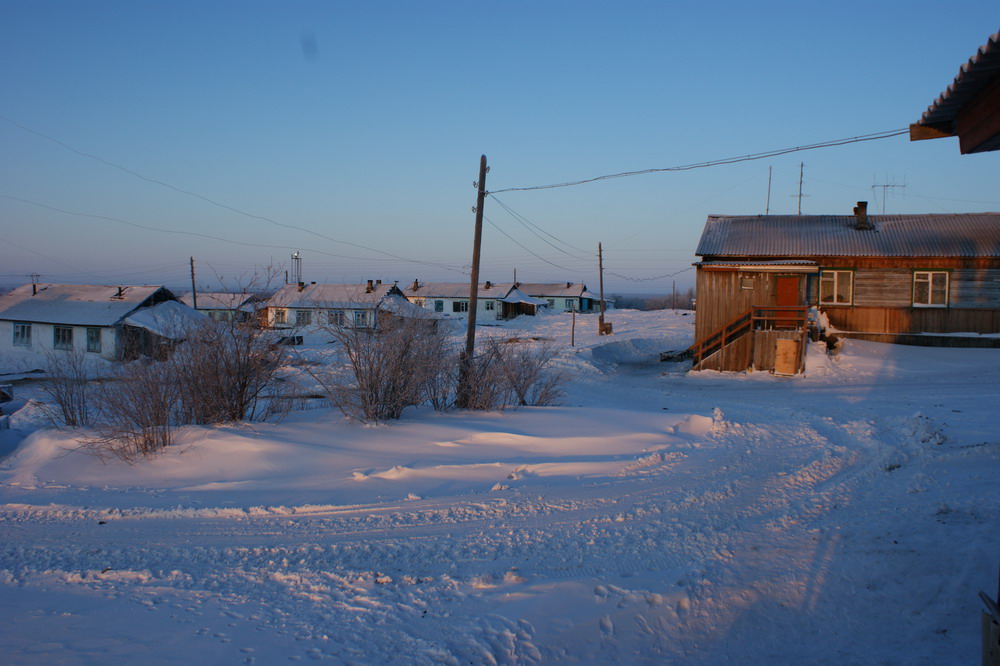
View of the Kotuy
Today, with the termination of life of the mine, go to the archives and data about the history and formation of the mine and the village. There remains a real possibility to communicate with a handful of old-timers, who share memories. They told the backstory of the mine. Seam coal, coming to the surface, was used by local people since time immemorial. On the site of the modern village was a small wintering. In the late thirties, early forties Kotuy coal is widely used for ships. Him chopped by hand. Especially rescued, the presence of mine during the war years: solid fuel carried in Khatanga bay, provided ships, coming and working in the Bay of Noordwijk.
Then in wartime on the agenda was a question on the development of the coal industry. Since manpower is not enough, brought ,the barge to the repressed people. They built the mine. Many have remained in village Kayak for permanent residence. Old-timers remember the stories of how families were created in the village. This is an amazing extraordinary decision was dictated by the actual existing conditions and needs that require authorization. Village erected hands of men. Women there was virtually no - if were a few, married.
Since it has been prescribed, to spend the male population more than one year, provided an opportunity to get families. To do this on a barge brought women from prisoners, say exactly in accordance with the number of men. dear Guest, met by a crowd of bachelors. Everyone got on woman. Most surprising in this story, as they say old-timers that by family, were very strong there was no divorce.
Nothing special in the mine Kotuy,no. The peculiarity of mine - that she almost horizontally, and coal corridor leads into deep the formation parallel to the earth's surface. Mined coal, by the way, a high-calorie, warehoused here on the bank of the river. In the fifties, the mine "Kotuy" began to supply solid fuel to meet the energy needs of the Khatanga District. Coal from Kotuy, enjoyed Volochanka, this Dudinka District, but the village is situated on the river Kheta, and convenient and efficient to provide all of its fuel Kotuy mine.
In Khatanga district acted expedient transport scheme to ensure the settlement of coal, developed and verified over the years. Spring, will be held floating of ice, Kotuy and Khatanga free from ice, steamers Khatanga seaport already here - at the pier Kayak. It was necessary to urgently dissolve coal in the southern villages of the bush, to catch on the big water. First of all - a caravan on Volochanka, then Katyryk, and Kheta. If more sent, the less remains for the winter, when the missing angle had to be delivered from the Kayak on large vehicles for winter road. Meanwhile free of ice the way to the northern villages - Zhdanikha, and the most distant: Novorybnaya, Syndassko, Popigaj.
Talking about the mine "Kotuy" can not ignore the human attention, who is remembered and venerated not only in Kayak, but around the settlement Khatanga and all Taimyr. Man, that mine Kotuy , was the meaning of life. More than forty years, from 1967 until his retirement from the life, gave his work - Shevtsov Nikolai Pavlovich, mining engineer, and since 1975 - permanent its leader, General Director of JSC "Mine Kotuy ". The ability of man, his talent and character are manifested in extreme situations requiring maximum impact and limit exertion. Nicholay Pavlovich had to work in difficult times - in an era of change. Despite enormous economic difficulties, Shevtsov managed keep mine "afloat".
As told Fokin Nikolay Andreyevich, which for several years worked as the head of the Khatanga District, Mine was of great importance, in the livelihood of the area. There are many advantages, in particular, mine next to the user, the quality of coal, the availability of jobs. For many decades the mine “Kotuy”, fully provide the needs of area, the fuel volume in tons 50-60, and "productive years" to produce up to 70 thousand tons. In recent years has depleted mine handed over their positions, and coal to provide the missing settlement fidgeted with Kayerkan and Yakutia.
At present, over the fate of Kayak village hangs a huge issue. Composition of the population of 154 people. Mine "Kotuy" has exhausted itself. For years, the leaders of the Khatanga District, and then, the direction of settlements, and mine proved rationale for the opening of the mine "New Kotuy ". In favor of the opening of the mine held a huge productive work. Whether the new mine will grow? Revive miner profession on Khatangsky earth? will come true miner's dream? will be all ships at berth, waiting for download black gold Kotuy? Revive manufacturing, providing us, the inhabitants of the harsh northern edge of what is most valued in the Arctic - the warmth? Will revive and strengthen the once flourishing village? In all these and other questions, villagers in Kotuy waiting for an answer, hope is literally a miracle.
14.06.2010 N.Kovalchuk
Translate: D.A. Pozdnyakov
- Details
- Parent Category: English
- Category: Communidat
-
Also available:


- Hits: 6812
Katyryk village is located two hundred kilometers southwest of Khatanga - is the final village southern bush settlement in a series in a series of settlements, located on the river Kheta. The forest surrounding the village are particularly rich. As seen, this promotes not that each degree - every minute of geographic north latitude, which in Katyryk south than at his brothers. Here and larch above, greener and luxuriantly, thick bush, and cowberry larger. Northerners (in this case villager Syndassko,Novorybnaya) by chance fall in this southern village, feel on the shore Kheta uncomfortable: "Because of your timber can not breathe here! The air is not enough. "So perceive forest grace northerners, who were born and raised on endless tundra open spaces, in a space where there are no forests the eye nothing catch. Where boundless, bordering the sea distance smoothly goes into the horizon. So it seems that only there they can breathe a full breast.
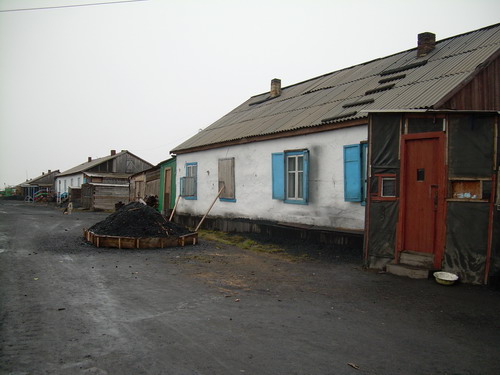
Competition courts in katyryk
But villagers in Katyryk long since used forest wealth, in everyday life, and art. It is the nature, the forest is always an inspiring start for artists and wood carvers. In addition to herbs, mushrooms, berries and game, forest and gave them fuel. in the spring, after the flood, whole village gathered together and do billet fin, which included in the river shore, generously left after ice drift. Before start of production coal on mine “Kotuj” wood was the only source of fuel. Local woods reliable building material. It is difficult to find a stronger northern larch - for the construction of the house.
Katyryk arose on the site Naltanovo. Settlement day timed the Day of Indigenous Peoples North and celebrated on August 9. Since 1936, the village began its history. It was then on the basis of a previously created experimental the farm for deer formed two reindeer herding co-operative. In 1938 they were converted to the Lenin collective farm. Villagers Katyryk remember the first name of the chairman - Bettu Stepan Ilyich.
With the emergence of the collective farm began intensive construction of residential and office buildings in the village. Moreover, they built from local durable larch. The war slowed down the construction, but in the next few years after the war the village had a dozen new semi-detached houses, bath, storage and other necessary capital building. For the nomadic population that has no permanent roof over their heads, It was a landmark event.
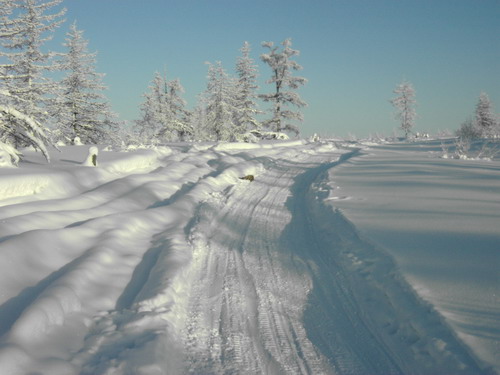
Winter road
The war has left its mark on this small village. Katyryk see off men, leaving in army. And those who stayed, worked up a sweat. Northerners do not tolerate celebration. Usually accustomed to labor from childhood. Active use of child labor in wartime. Taking advantage of the presence of the material, people of twigs woven baskets for fish. They loaded catch, to send to the front.
Chronicle of the village said that before the start of the sixties of the last century Katyryk he was a member of the Avams region. In 1961, there was an association of three small collective farms are geographically close to each other. “Rodina”( Boyarka), Krupskaya collective farm (Kargo) and Lenin collective farm (Katyryk). The newly formed joint farm with the central manor in Katyryk called "Banner Ilyich".Since then, the village became part of the Khatanga District. In the future, the economic status of the village changed several times : the farm, the Department of State Farm “Khetskiy”, and in recent years before the restructuring he was independent State Farm “Katyrykskiy”.
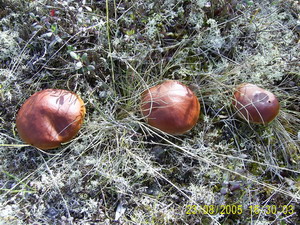
Forest wealth
The main branches of the farm, did not differ from other : reindeer (before 1980), fur and fish trade, animal breeding. Yet, unlike other farms, in Katyryk production of reindeer, received priority in economic activity. This was facilitated by the geographical position of the village : he was on the path of intense migratory movements reindeer. Migration also served as the main cause of failure by reindeer : during its travel wild deer mass wedged into in herds of domesticated reindeer and led away in tundra ,reindeer.
Production of wild deer took a very rational, successful and in large quantities. Created teams : to shooting and to workpiece meat. They settled permanently in the migration period deer deer in areas with comfortable crossings : that is where the animals crossed the river. For the storage of meat were built powerful roomy glaciers some of them are still in use.
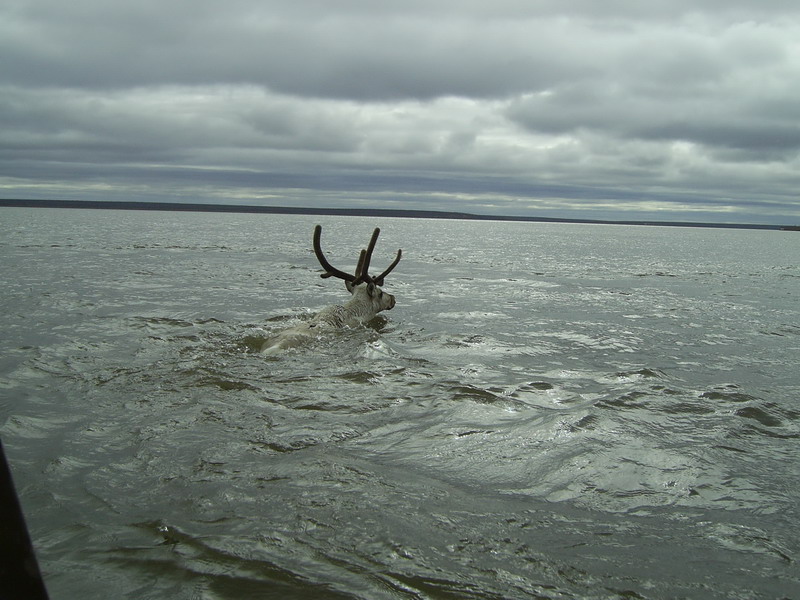
Deer
If we talk about the features of the village - presence in his district limestone. Villagers fired bricks, then quenched. Slaked lime for many decades used to whitewash housing.
Katyryk – village Dolgan. Of the 342,330 inhabitants – Dolgan. Part of the population is employed in budget organizations. There is a primary school, a library, post office - all, as in all. A significant part of the population have status nomadic. Men are engaged in fishing and production meat. Seventeen people united by a common activity in the agricultural cooperative “Katyryk”. In 2009, in the village there were two new object: Helipad and a diesel power plant.
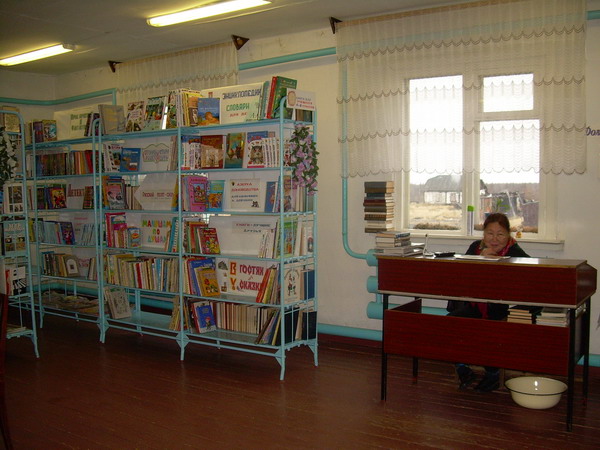
Library in Katyryk
Villagers live friendly team: common challenges, common holidays. Approximately half of the population - children and young people up to thirty years. In Katyryk very strong active young people.
As the head of the territorial department of the village Elsa Pyurbeeva - Youth team - reliable assistant, which can rely administration village and public organizations. Chairman of the youth of the village center “Rebirth” - Andrei Sotnikov, rallied around him, the fifteen most active boys and girls. They try to make the life village lively, interesting and with meaning.
Young people are actively delve into all spheres of social, cultural and social life of village. Actively helping the elderly, fighting for cleanliness and order in the village. Successfully organized for fellow leisure time. Around the youth activists focused not only youth, but also to all the villagers.
Katyryk - a deep province, isolated from the outside world. This fact contributes to the development of creative people, if they are not indifferent to others and to ourselves. And simple day, and holidays they arrange themselves.
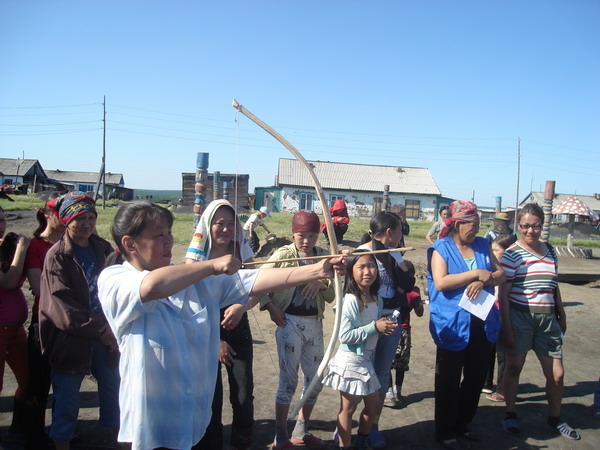
Young people day
The artistic possibilities village youth It is known the entire population. Repeatedly guys traveled with concerts in other villages, including to Khatanga. In their creative performances the guys open talent writers, directors, performers. Auditoriums applauded - Vitaly Rimkus, Andrey Sotnikov, Dmitry Eremin, Elizaveta Sotnikova, Gregory Eremin and other amateur artists.
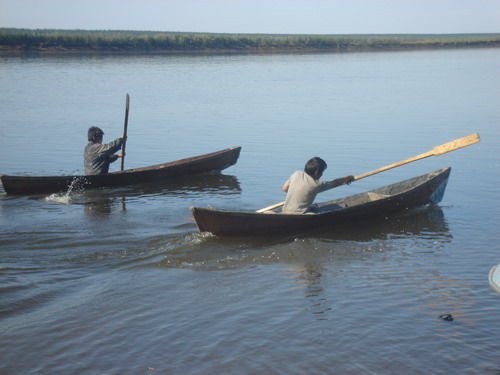
Fishman day
Creative talents guys showed the creation of youth comedy movies “Eralash” participating in the video contest, both at the level of settlements, the district. Villagers - winners of numerous competitions. Outside their village, boys demonstrated their achievements not only in song, dance and drama works, but the best examples of traditional occupations : Embroidery, fur products, leather ,manufacture of national clothes and other items, authors are their countrymen, great masters.
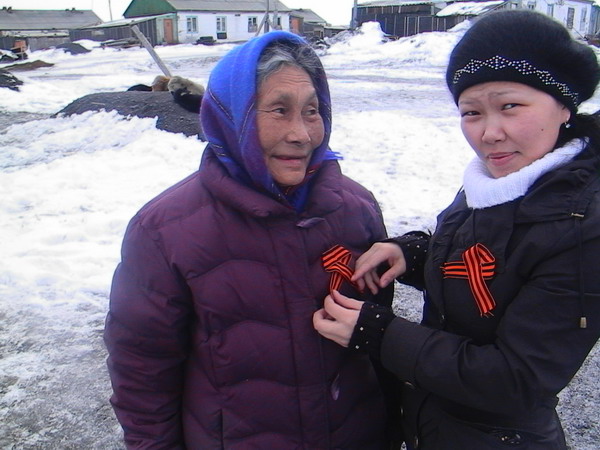
Victory Day in Katyryk
A problem? Problems, of course, is, they are common to all northerners. Villagers in Katyryk live with hope and faith to their gradual decision.
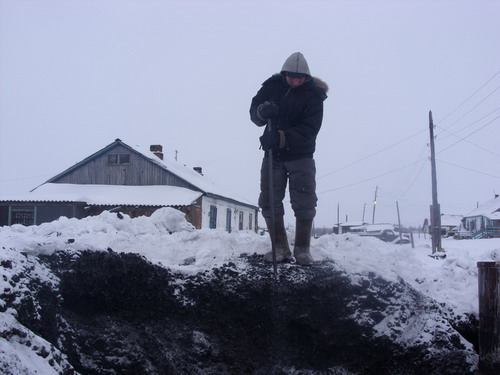
Help old people and disabled
10.03.2010 N.Kovalchuk
Translate: D.A. Pozdnyakov
- Details
- Parent Category: English
- Category: Communidat
-
Also available:


- Hits: 4893
If to get in Khatanga on the steamship and to head for northeast, downstream the river, that through 30 kilometers because of the cape It is possible to see village Zhdanikha, with a huge door of a glacier. On the high right river bank once nomadic people have made the place for cattle.
Villagers Zhdanikha, they can not called exact date emergence village. But in one of the editions of the article journal “Ethnographer” there is a message of the author V.Vasilyeva, which was originally published a hundred years ago 12.01.1908 in St. Petersburg edition “Siberian questions”. Researcher, recreated history Promotion Russian people to the North, in its article mentions village Zhdanikha how about the village, In which at one time life began with a higher culture, than surrounding her … , but now now there complete desolation. Therefore, in the winter in Zhdanikha live only one family. In this way, can be assumption, this village was born much earlier 1908.
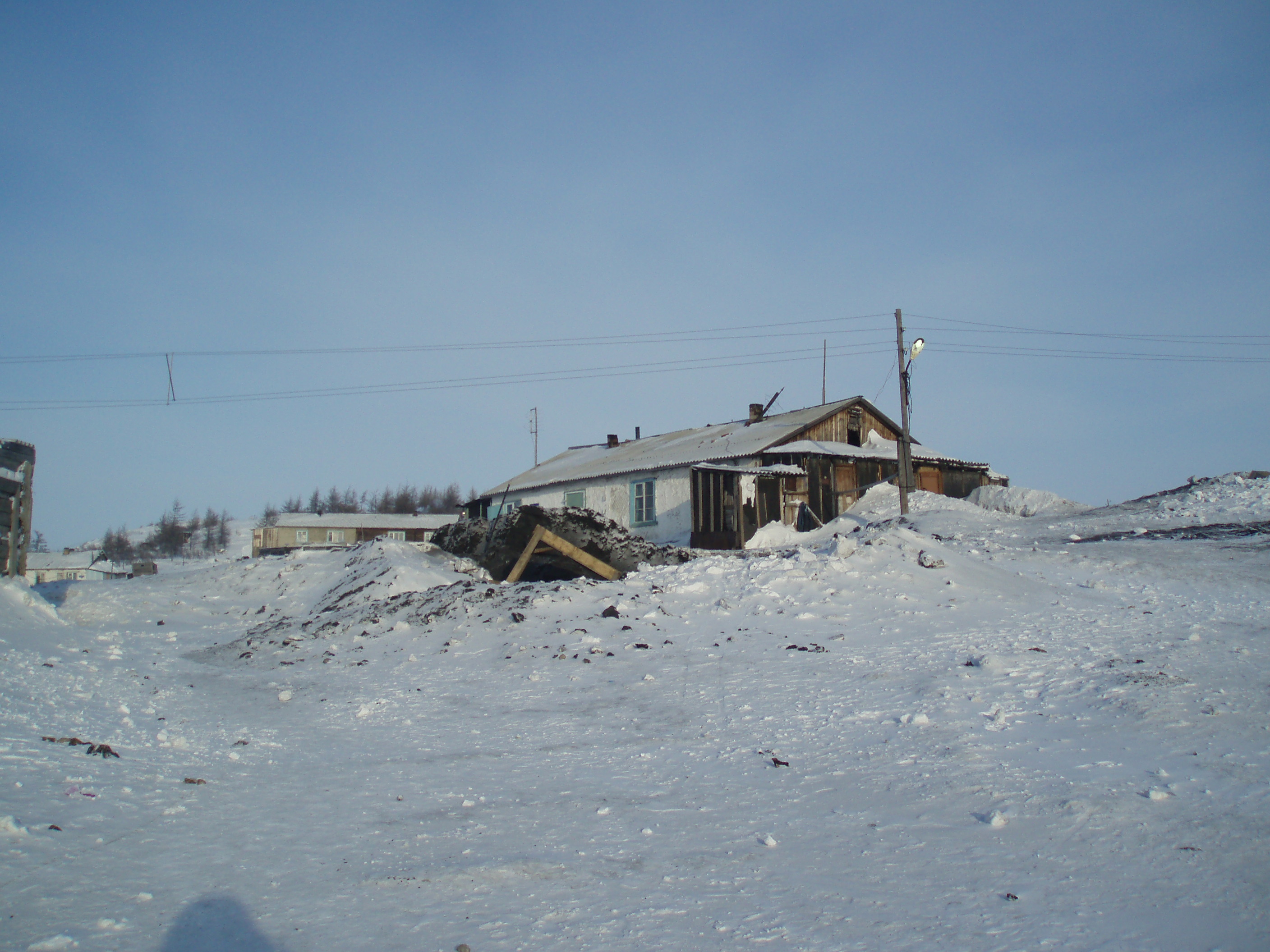
View of the Zhdanikha
Centuries have passed, the place for cattle became village. Beauty opens to the river, with located on the terraces slopes one-story houses. Neat, against the background of a low polar forests, village looks very comfortable. Many situations, seeming in the village usual, are becoming sense bright memorable phenomenon. For example, the arrival of the motor ship or helicopter, even the emergence of the new man in village – big event.
In archive, date of creation village is specified 15.04.1942, when the government adopted a resolution of the full development of the fishing industry in river Siberia and Far East. From that date, Zhdanikha leads its years of life. Fact, it has been said, village life begins before is specified date. Truth, before villagers lived slightly farther from that place where now settles down Zhdanikha in present day, this place was called Novo-Letovye. Here lived the local population and immigrants – repression, people which have become memorable part village. In the forties on the base Novo-Letovye was organized collective farm Named Molotov, he consisted of the local population and immigrants. Collective farmers they were busy breeding deers, fish and hunting. Was organized brigades of the local population and brigades of the immigrants, where brigadier was wonderful woman, which people remember still - Diehl Julia Andreevna.
According to old-timer, in village lived and worked very in a friendly fashion. The first and explanatory, successful chairman collective farm “Zary” (ex- collective farm Molotov) became german Verveyn Karl. During these years, the local population more engaged traditional activities, and immigrants basically – canning mushrooms, berries. On a hillside of hill created kitchen-garden, people was grown vegetables. Indigenous northerners have seen how growing potato, carrot and onion.
In 1959 collective farm “Zary” was named Lenin. His chairman became,native of village – Portnyagin Trifon Ilyich, deputy the Supreme Council RSFSR. With time in village appeared post office, shop, bakery and farm of animals, where breed beauties black-brown foxes, then, arctic foxes.
In the seventies the development of the national economy developing well, collective farm Lenin among best. Worked several brigade: reindeer breeders, hunters, people was which engaged furs,peoplewas which engaged was murder home reindeer - on these works was busy almost all population which can work.
In 1975 on the basis of the collective farm was founded state farm “Central”. First chairman – Afanasiy Spiridonov. Second chairman - Mariya Nikolaevna Datsyuk, Anna Ivanovna Lavreshyk - who made a great contribution to the development of the farm. In the eighties was appointed to the post chairman Bogomolniy Anatoly Lvovich. In the these years, village, begin, to blossom. Widely construction began residential homes. Put into operation sewing workshop, primary school, brick building power plants, kindergarten, administration building. Completed construction of the baths.
Not so long ago, a quarter of a century ago, says the head of the territorial department of the village of Nadezhda Chuprina, the village was known as a successful fur farm : there have been divorced, very fluffy's and very beautiful in Taimyr, rare vaulevy blue arctic foxes. The economy collapsed in the post-Soviet years, material and technical base ruined, but experienced breeders in village still have. Nadezhda Konstantinovna hopes, that via targeted programs can revive farm farm for arctik foxs.
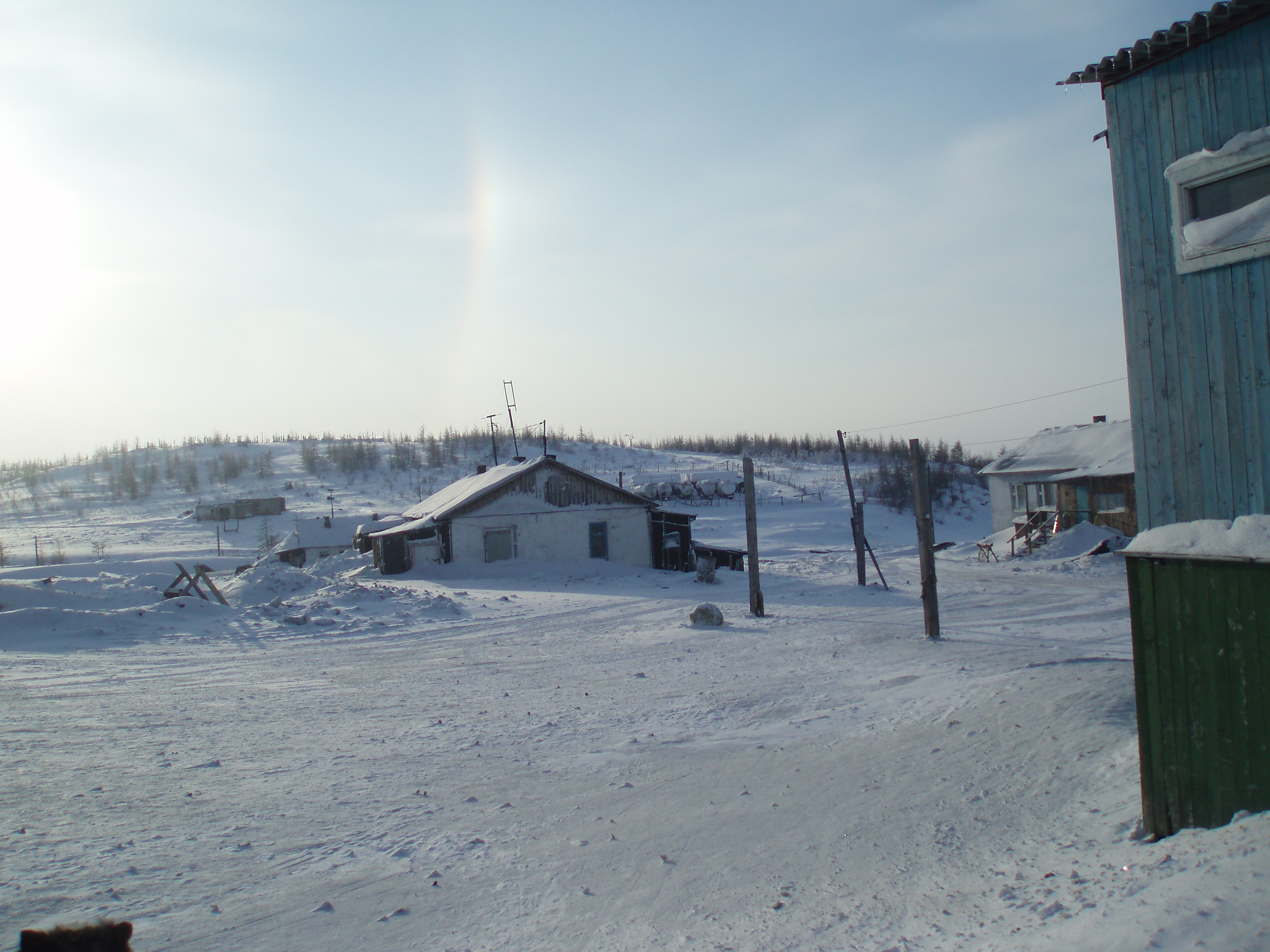
View of the Zhdanikha
The population in the village of 250 people, mainly dolgan people, but there are a few people, Nganasans and Russians. According to the chief of the settlement of the territorial department in Zhdanikha there 131 people which can work. 22 of them work at the two farms – PRA “Central” and community “Barak”. Some residents Zhdanikha – workers budget sector. There is here kindergarten, located in the same building a primary school. Country club, library, post office, shop, medical and obstetric centers, diesel power – this basic mini-infrastructure, providing employment. As in other villages, the big problem with the work, have unemployed, but change your status they are unlikely to be able to in the future, 23 people have a status nomads.
In the village working public organizations : women's council, primary organization KMNS, public administrative commission, youth township center “Unity”.
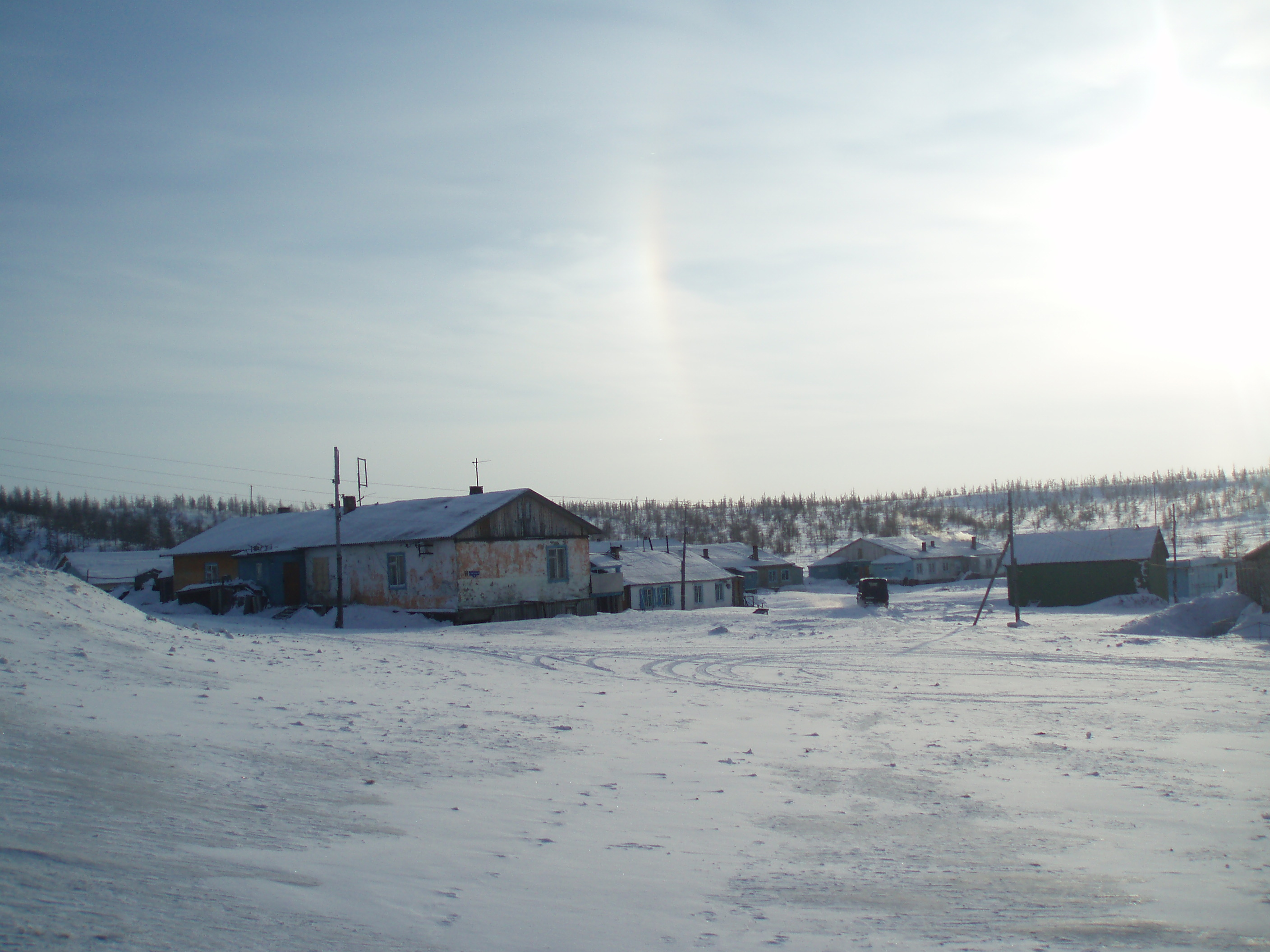
View of the Zhdanikha
An interesting historical footnote - one of the elements “distinctive feature” this village. Zhdanikha - she stands on the high bank in the forest, "Face" turned toward the river, and houses scattered on different levels, depending on the height of the slope, on which found shelter. Gully separates residential part of the village from cemetery. But cemetery there are in the Zhdanikha. This is not buried already 60-70 years. Silent memories of the buried - one of the attractions of the village, reflecting historical processes taking place in the country. Cemetery called German - because here are buried repressed Germans. But memory old-timers transfers from generation to generation stories, lie here and Latvians and Lithuanians and people of other nationalities - victims of severe pre-war Stalinist era. Here they were exiled, lived here,died here. And they left a big, good mark on the soul and memory of indigenous northerners.

View of the Zhdanikha
here no tombstones, no inscriptions. Who, where is buried, no one knows and does not know, probably never. But paying tribute and compassion, villagers Zhdanikha cemetery fenced fence and painted. To no one even dogs did not run, not worried. Wooden crosses lost in the middle of the forest and merge with nature. Here is such an island of peace, which Dolgan by unwritten law, revered as a shrine. Silence, cleanliness, tranquility.
23.06.2010 N. Kovalchuk
Translate: D.A. Pozdnyakov

